MAY/JUNE 2023
LOCAL AUTHORITY BUIL DING& MA INT ENA NCE
HOUSING & REGENERATION
TECHNOLOGY IN CONSTRUCTION

ROAD TO ZERO CARBON FIRE PROTECTION & SECURITY

HOUSING 2023
We preview the biggest event on the housing calendar
EMBRACING NEW TECHNOLOGY
Wates Residential’s Geraint Sewell talks to LABM about the challenges surrounding housing decarbonisation and how innovative new technologies can help decrease construction and post-occupancy emissions

THE LEADING MAGAZINE FOR LOCAL AUTHORITY AND HOUSING ASSOCIATION SPECIFIERS

LABMONLINE.CO.UK

6 news
VIVID secures £100m facility Golding Homes adopts Sustainability Reporting Standard Changeworks publishes research into fuel poverty in rural Scotland

7 thermal Performance insights with a. Proctor group
Advice on improving the thermal performance of existing homes
8 Project update
North Lanarkshire Council’s Holehills Regeneration Bromford’s biggest-ever land led site Karbon Homes’ Ponteland retirement living scheme
10 industry comment
Matthew Warburton, Policy Advisor at the Association of Retained Council Housing (ARCH) looks at the new Tenant Satisfaction Measures
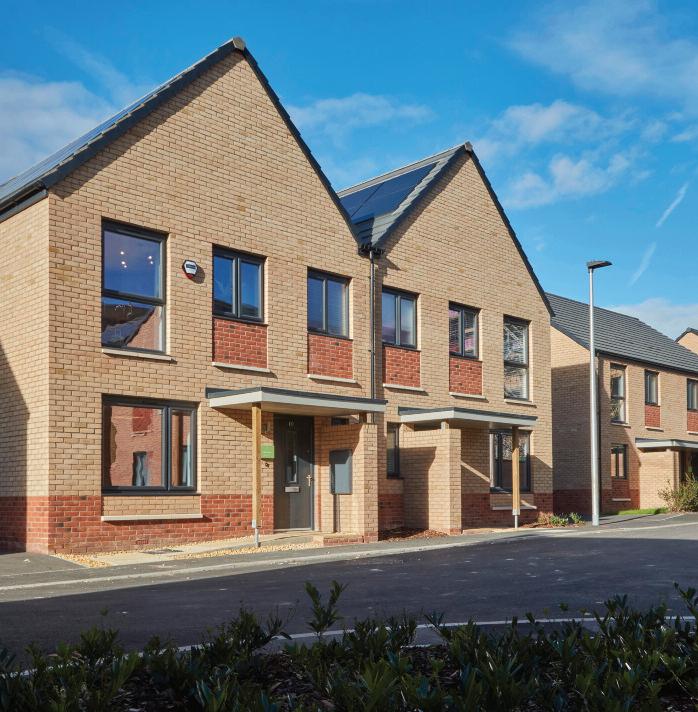

12 Housing Fit for the Future
Nigel Sedman, Executive Director of Homes at ForHousing, discusses the importance of working in partnership
14 View from the Supply chain
John Mellor from Glidevale Protect highlights the need for greater data transparency in construction
15 under Warranty
Global Home Warranties tackles the issue of quality control in new homes
advice for local authorities and housing associations on improving the energy efficiency of existing homes

HouSing & regeneration
43 Low carbon construction with Structural timber
The STA tells LABM why it believes structural timber presents the greatest opportunity for low carbon construction
46 rising to the challenge
Frameworx addresses the challenges and opportunities surrounding the decarbonisation of existing housing stock
48 round-up
Fire Protection & Security
50 new building and Fire Safety
Framework
A guide to the new framework launched by Pretium Frameworks and the Hyde Group
53 breaking point
tecHnoLogy in
conStruction
The safety risks surrounding the use of monolithic glass in high-rise residential buildings and an alternative solution
56 round-up
new framework for housing providers
Glasgow
health and care
Why
showers can
ease financial pressures for property owners and occupants
From one Home
Improving the energy efficiency and environmental performance of existing social housing 35 round-up 37 embracing new techology Working with supply chain partners to embrace new technologies and decrease emissions during new home construction and throughout a property’s lifetime 39 round-up 40 award Winning Performance C I B S E d i s c u s s e s S w a n s e a C o u n c i l a n d t h e W e l s h S c h o o l o f A r c h i t e c t u r e ’ s a w a r d w i n n i n g p r o j e c t t o e n e r g y - e f f i c i e n t l y r e t r o f i t t o s i x b u n g a l o w s
M A Y / J U N E 2 0 2 3 L A B M I 3 reguLarS
Work
24 building a concrete Future The specification of concrete bricks for New Gorbals Housing Association’s North Gate Development in
27 digital transition The role of technology in improving
in social housing 30 easing the Pressure
choosing electric
help
33
to every Home
CoNTENTS
5 comment
of Art
| 50 How new tech can help deliver net zero | 37
| 33
May/June 2023 Vol 39 No 3
road to Zero carbon

Editor Claire Clutten
labm@hamerville co uk
Advertisement Manager
Jacob Tatum jtatum@hamerville co uk
Group Advertising Manager


Craig Jowsey
Digital Manager
Jasmine smith
Jsmith@hamerville co uk
Digital Assistants
david molloy
Toby Richardson
Design
Adeel Qadri
Group Production Manager
Carol Padgett
Circulation Manager
Kirstie day
Wo r k o f a rt
Public art has a vital role to play in connecting people to places, especially on new developments, helping to promote thriving communities and create a sense of identity so it was a real privilege to be asked to be part of the judging panel for this year ’ s Blunden Prize public art competition, run by housing association, stonewater
stonewater has been commissioning local artists to deliver public art pieces for its new developments for a decade now in 2021, the housing association launched the Blunden Prize national competition as a retirement gift for former stonewater Chair, George Blunden, who believed passionately that ‘homes are more than bricks and mortar’, and that the area around people’s homes ‘should impress not depress’
Published by Hamerville media Group Regal House, Regal Way, Watford, Herts Wd24 4YF 01923 237799
Email: labm@hamerville co uk
The brief for this year ’ s competition was to design a concept for an art installation within a set budget for the housing association’s new Calverley Lane scheme in Horsforth, Leeds When complete, the development will provide 152 new affordable homes on the site of the former Leeds City College campus, close to the Rodley nature Reserve and the high street in Horsforth
encourage people to the visit area? The last thing anyone wants to do is deliver something that no one understands For stonewater, the extent to which the artist considered engagement with the local community to influence their final design was also important over 50 entries were received and whittled down to a shortlist of just eight i was invited to stonewater’s offices in Reading for the day to join fellow judges stonewater Chairman sheila Collins, CEo nicholas Harris, and Chief Growth & development officer Jonathan Layzell in interviewing the final eight
© 2023
subscriptions to LABm are available at the following rates: UK: 1 year £30 00 post paid Europe and Overseas: 1 year £50 00 post paid
Airmail: 1 year £65 00 post paid
(1 July 2021 30 June 2022)


To be removed from LABM’s circulation please call 01923 237799 or email: circulation@hamerville.co.uk
Prospective artists were tasked with designing an art installation that reflected the local area and vernacular, with a nod to the new development in some way sustainability is hugely important to stonewater; all their new developments embrace low carbon technology, are designed with energy efficiency in mind and include provisions for green space so it was essential that the artists’ factor this into their choice of materials, taking into account the use of local materials, ethical sourcing and environmental impact for example The winning piece of art will need to stand the test of time too, so durability and resilience were also essential ingredients
Will the art installation create a striking visual impact and sense of identity? Will it resonate with the local community, create a focal point and leave a positive lasting impression? Will it
it was an incredibly tough job The variety and quality of the shortlisted entries was impressive, clearly a great deal of time, thought and effort had gone into the submissions The level of research some had done into the local area and its rich history particularly impressed me, especially how they managed to translate that into the designs Using art to foster and reinforce a sense of community and belonging can be incredibly powerful, and this was also reflected in the designs
The competition provides a fantastic opportunity for local artists to be a part of something extremely positive and enduring i’d like to say a big thank you to the artists for sharing their wonderful ideas with us, and also to stonewater and see media for inviting me to be on the judging panel, it was a great experience
After much deliberation, the finalists were chosen and all that remains is for a winner to be announced at an event in the summer Watch this space
Wates Residential is working with Cardiff Council to deliver the Cardiff Living development programme, which will to provide 1,500 new homes across the city over 10-years Turn to page 37 to find out more about the development programme and how working with supply chain partners to embrace new technologies can help reduce emissions
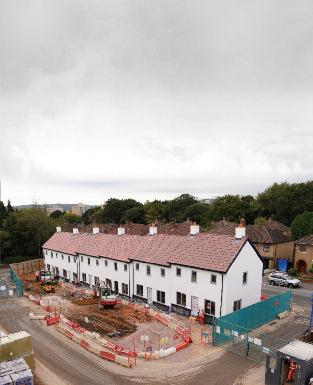
m A Y / J U n E 2 0 2 3 L A B m i 5
Printed by WALsTEAd RoCHE
EdiToR’s CommEnT
11,374
STORY: “ U s i n g a r t t o fo s t e r a n d re i n fo rc e a s e n s e o f c o m mu n i t y a n d b e l o n g i n g c a n b e i n c re d i b l y p owe r f u l … ” N N C EM EW Y W G k b g o d - p MAY/ 0 3 O AL AU HO Y BU LD N & MA N EN NCE G 2 2 p g h d
COVER
IN BRIEF
VIVID secures £100m facility
Affordable homes provider VIVID is continuing to use its ESG credentials to attract investment, this time announcing a new £100m Sustainability Linked Facility from ABN AMRO Access to this funding and facility supports VIVID’s objective to build and develop more energy-efficient, affordable homes The facility is unsecured and has metrics linked to the organisation’s environmental, social and governance (ESG) work, helping incentivise a positive impact for the organisation’s customers and communities The new facility was announced three months after VIVID secured the sector’s first green loan
Golding Homes adopts Sustainability Reporting Standard

Maidstone based local housing provider, Golding Homes, has adopted the Sustainability Reporting Standard (SRS) for Social Housing, a voluntary reporting framework that takes account of the work the organisation is doing to address its impact on the environment

David Hart, Director of Finance and Procurement at Golding says: “Adopting SRS is a natural progression for us in our desire to make Golding greener and we ’ re delighted to take this step forward Last year we produced our first ever Environmental, Social and Governance Report setting out our commitment to reducing any negative impact of our work on the environment Our new Environmental Sustainability Strategy builds on this The SRS framework covers 48 ESG criteria and will support us to focus on affordability, carbon emissions and energy efficiency, safety, equality, diversity and inclusion and the customer voice ”
Atkins, part of the SNC-Lavalin Group, is set to deliver planning and design services for a major urban extension in the West Midlands.
The scheme will make a significant contribution to meeting housing needs, including affordable housing, in the area, while also providing new schools, healthcare, retail provision, green areas, community spaces and infrastructure improvements for the wider community
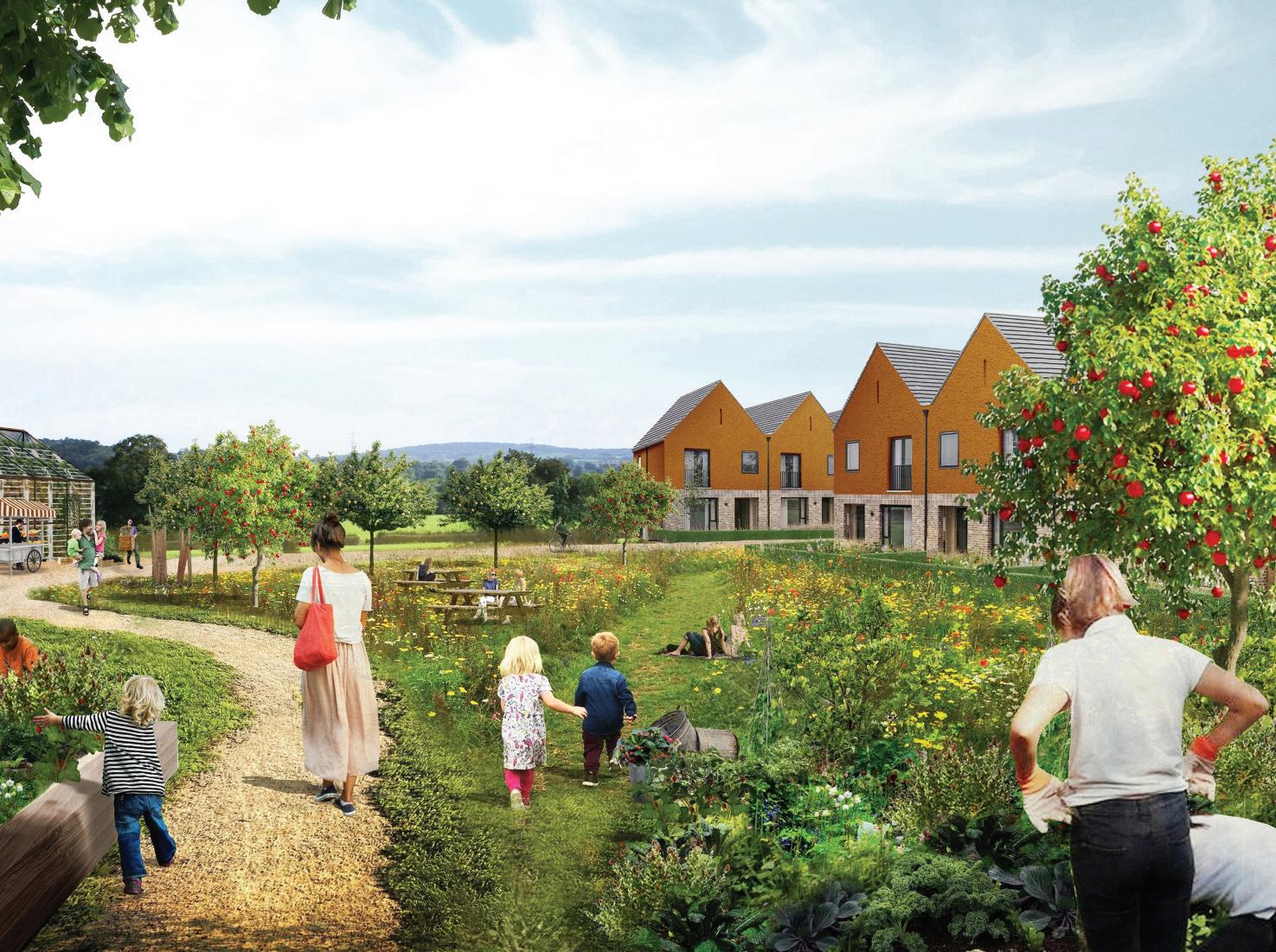
The engineering and design consultancy, working with supply chain partners LDA Design and Levitt Bernstein, has been appointed as masterplanner and multi-discipline designer for Homes England’s portion of the 4,000 homes that remain to be delivered as part of the South West Rugby Urban Extension
Alongside this, sustainability and biodiversity net gain are embedded in the approach as Atkins will ensure the environment plays a key role in benefiting communities, whilst minimising the impact on nature

t h a n s i m p l y b u i l d i n g h o u s e s t o m e e t t h e a c u t e d e m a n d T h i s p r o j e c t a n d t h e p h y s i c a l a n d s o c i a l i n f r a s t r u c t u r e t h a t i t w i l l d e l i v e r w i l l c r e a t e t r u l y t h r i v i n g p l a c e s b a s e d o n s a f e a n d s e c u r e h o m e s , p r o d u c i n g b e t t e r s o c i a l v a l u e o u t c o m e s I t a l s o r e p r e s e n t s a p r i o r i t y d e v e l o p m e n t w i t h a c l e a r f o c u s o n c r e a t i n g a s u s t a i n a b l e c o m m u n i t y w h e r e p e o p l e c a n l i v e , w o r k a n d p l a y f o r g e n e r a t i o n s ”
Ben Frodsham, Senior Planning and Enabling Manager for Homes England adds: “Atkins has been providing services for Homes England for many years and has a strong track record of delivery both nationally and in the Midlands region
“The team was able to demonstrate a joined-up and efficient approach to the scheme, bringing some trusted supply chain partners in to add additional value including LDA Design and Levitt Bernstein
“We have great confidence they will deliver what is needed to support Homes England in the delivery of a vibrant, sustainable and successful new community in South West Rugby ”
J o a n n e F a r r a r , P r o j e c t D i r e c t o r f o r A t k i n s , s a y s : “ T h i s i s a h u g e l y s i g n i f i c a n t d e v e l o p m e n t t h a t w i l l h e l p t o m e e t t h e r e a l n e e d f o r h o u s i n g i n t h i s p a r t o f t h e W e s t M i d l a n d s B u t t h i s i s a b o u t m o r e
NEWS
A t k i n s t o d e l i v e r m a s t e r p l a n f o r H o m e s E n g l a n d ’ s R u g b y s c h e m e
CGI from LDA Design
Fuel poverty in rural Scotland


The impact of far higher levels of fuel poverty on the physical and mental health of people living in rural areas of Scotland is outlined in new research published by Changeworks.
Comparing three regions Caithness and Sutherland, Highlands and Islands and remote rural areas the analysis shows not only that fuel poverty affects proportionately more households in these areas compared to the rest of Scotland, but that the depth of fuel poverty is worse
Interviewed for the report, people with lived experience of fuel poverty and frontline advisors told researchers that the far higher levels of fuel poverty have clear impacts on individuals, often resulting in poorer health and social isolation
Commissioned by the Rural & Islands Housing Associations Forum (RIHAF), the Highlands & Islands Housing Associations Affordable Warmth group (HIHAAW) and Highlands and Islands Enterprise (HIE), the report sets out the drivers, impacts and extent of fuel poverty in rural Scotland

The report also outlines clear solutions that the Scottish and UK Governments and Ofgem can take to alleviate the issue This includes improving the identification of those with enhanced heating needs, broadening the eligibility of existing support, delivering more support on the ground through community anchor organisations and wider reforms of the energy market
More details on the research here www rdr link/lak001


A copy of the full report is available to download here www.rdr.link/lak002
A copy of the solutions paper is available to download here www.rdr.link/lak003
Thermal Performance Insights with

Increasingly within the housing sector, there is recognition of the urgent need to improve the energy efficiency of our existing housing stock In doing so, strategies for retrofitting existing buildings are of crucial importance Equally, preserving the lifecycle of buildings is a priority, more than ever due to the rising energy costs
The objective is securing the future of our ageing housing stock by providing warm, damp/mould-free living space When considering the insulation of buildings, we refer to U-values, which quantify the rate of heat loss through a building element such as walls, roof, windows, and doors The lower the U-value, the slower the heat generated by the heating system will escape, and less energy input is required to maintain a comfortable internal temperature
Where thermal performance is poor, this has a significant impact when occupants are in fuel poverty or belong to a vulnerable social group such as the elderly This can lead to health problems for these groups, so upgrading such homes is a priority
With improved performance in mind, the A Proctor Group developed Spacetherm WL, a high-performance laminate specifically intended for use where internal space is limited Spacetherm WL is fixed to the internal surfaces of existing walls without the need for mechanical fixings Consisting of a Spacetherm aerogel insulation blanket bonded to 3mm Magnesium Board (MgO), at just 13mm thick, there is often no need to remove skirting boards and cornices, saving time and cost For example, a typical solid wall will have a U-value of around 2 1 W/m2K, and after installing Spacetherm WL, this can be reduced to around 0 8W/m2K, dependent on the wall structure



This makes Spacetherm ideal for use in rooms with limited floor area, at door and window reveals, and in other areas where retaining existing features would otherwise limit the use of thick and bulky insulation The thermal conductivity of Spacetherm, at 0 015 – 0 0195W/m2K, makes it among the best thermal insulants in use today, combined with its high vapour permeability, making it ideal for refurbishments

M A Y / J U N E 2 0 2 3 L A B M I 7 n More information on Spacetherm here: www.proctorgroup.com/products/spacetherm
John Johnston, Sales Director at A. Proctor Group, addresses the thermal performance of existing housing stock.
New solar batteries will help North Lanarkshire Council tackle fuel poverty
That is the view of Arc-Tech (Scotland) Managing Director, john Gallacher, whose company is responsible for the installation of north Lanarkshire Council’s first solar battery storage units at the Holehills Regeneration in Airdrie
Located on Dykehead Road northeast of the town centre, 150 two- and threebedroom homes for social rent are replacing a series of multi-storey flatted blocks as part of the Council’s target to build 5,000 new homes across the local authority region by 2035

Of the 150 homes, 19 are being delivered to a piloted net zero carbon standard of build that has been developed by main contractor, CCG (Scotland), with the support of Arc-Tech who specialise in the delivery of Mechanical & electrical (M&e) services and the design and installation of renewable energy systems each net zero home has its own battery storage unit; known as the ‘Powerwall’, it is
supplied by the world-renowned car-maker and clean energy company, Tesla

The battery links to solar PV panels installed on the roof, which capture energy from the sun during daylight hours under normal circumstances, the occupier will only benefit if the energy is used at the time of generation, however, if it is not, the energy is exported to the national Grid
Rather than losing out on energy being lost, the battery retains energy for later use, even during a power outage, which allows the occupier to benefit from variable tariffs during the evening
The combination of the renewable energy system and the enhanced built form delivers a minimum energy Performance Rating of 104 (A) the average rating in Scotland is 61 (D) representing significant betterment for the occupier and the environment
john Gallacher, Arc-Tech (Scotland) Managing Director, says: “Arc-Tech is one of the few companies that are certified to
install these hugely innovative solar battery storage units, alongside eV connector points, on behalf of Tesla in Scotland It is an exciting time for renewable tech; the system in place here is incredibly intuitive and, when combined with excellent fabric performance characteristics, it will go a long way to supporting residents during this prevailing cost-of-living crisis ”
Dykehead Road is supported by a grant funding contribution of £9 7m from the Scottish Government and is due for completion later this year
north Lanarkshire Council, Housing Convener, Councillor Heather BrannanMcVey, adds: “I’m delighted to see our first net zero homes available for tenants here in north Lanarkshire These homes reaffirm our commitment to embracing and investing in new technology that improves energy efficiency and comforts for our tenants, reduces emissions and consumption while minimising fuel poverty ”
PROjeCT uPDATe neWS:
8 I L A B M M A y / j u n e 2 0 2 3
Solar batteries installed at a new affordable housing development in North Lanarkshire are seen as a major step forward to tackling fuel poverty and climate change.
Bromford secures planning permission
Housing association



Bromford has secured planning permission for its biggest-ever land led site in Gloucestershire Tewkesbury Borough Council finalised its approval for the construction of 100 new homes at Bromford’s 16 8 acre site at Delavale Road in Winchcombe
The development will comprise 50 affordable homes for rent and shared ownership, and 50 homes for outright sale Homes will range in size from one-bedroom flats to five-bedroom houses, some of which will have dedicated home office space to encourage flexible working A number of new trees will be planted across the site, which also includes a play area, while a new pedestrian and cycle link will be created to link the new homes to nearby Mercia Road
Matt Batham, Head of Pre-Construction at Bromford says: “By providing 50% affordable housing on the site, this development will give more local people the opportunity to stay living in the area who otherwise couldn’t afford to live in the town This is the biggest site we have purchased so far and forms part of our strategy of increasing the amount of land we buy and develop ourselves ”
Energy-efficient retirement living scheme

Good progress is being made on the development of a new energy-efficient retirement living scheme in the Northumberland village of Ponteland Karbon Homes’ £5 5m ‘Athol House’ scheme on Callerton Lane will provide 34, much-needed affordable apartments for over 55s, with one- and two-bed homes available for a mix of affordable rent and shared ownership


The scheme is being constructed by EQUANS and will benefit from a communal green heating system, powered by commercial air source heat pumps, which will supply the communal areas of the scheme and each apartment with underfloor heating and hot water
Zoey Hawthorne, Assistant Director of Development Delivery at Karbon Homes, says: “We’re delighted to bring these much-needed apartments to Ponteland and have worked hard to create a scheme which meets the needs of the local community We’re particularly excited about the inclusion of a low carbon heating system, which will not only help residents save money on their energy bills but will also significantly reduce carbon emissions produced by the scheme ”
Pictured from left to right: Gary Hall from EQUANS, Sara Armstrong from Karbon Homes, Louise Buckton from EQUANS and Shaun Sinclair from Hall and Partners
Te n a n t S a t i s f a c t i o n
M e a s u r e s t h e
c h a l l e n g e a h e a d
Matthew Warbur ton, Policy Adviser at the Association of Retained Council Housing (ARCH), discusses the new tenant satisfaction measures, which are being introduced by The Regulator of Social Housing as par t of a new system for assessing how well social landlords in England are perfor ming.

The requirement on social landlords to collect information for the new tenant satisfaction measures (TSMs) came into effect from 1st April. For some of the TSMs, this means landlords should already be collecting the relevant information, for example, on the number of repairs carried out within target times, or the number of complaints received

For the 12 TSMs to be collected from tenant participation surveys, the task is to commission and schedule appropriate surveys at some point during 2023/24 and arrange to repeat them annually But for other indicators, including arguably the six most challenging, 31st March 2024 has become an unyielding deadline that is likely furrowing brows and keeping managers awake at night or ought to be in many councils and housing associations just now.
The six TSMs in question are RP01 the number of homes that do not meet the Decent Homes Standard, and the five BS indicators that relate to the percentage of gas, fire, asbestos, water and lift safety checks carried out. These are the most challenging indicators because for each of them there is only one score that can be reported to the Regulator next year without fear of regulatory comeback, and that is 0 for RP01 and 100% for the other five
Which is not to suggest that landlords don’t have to worry about regulatory comeback until summer 2024 Until the Social Housing (Regulation) Bill is enacted and comes into force, the Regulator’s powers to enforce the Consumer Standards, including the Homes Standard to which all these indicators currently relate are limited to cases where there is a risk of, or actual, severe harm to tenants But precisely because the BS indicators relate to key safety checks there can be a strong presumption of a risk of serious harm if they have not been carried out
Decency criteria
On decent homes, landlords might be able to justify reporting homes that do not comply with the decency criteria requiring a reasonable state of repair, reasonably modern facilities or a reasonable degree of thermal comfort, especially if they can show budgeted plans to improve them in the near future. But no excuses are likely to be accepted for the continuing existence of serious (category 1) hazards as defined in the Housing Health and Safety Rating system
Recent action by both DLUHC and the Regulator in relation to damp and mould has demonstrated both that the issue is, rightly, judged of high priority and high enough risk to meet the serious detriment
“ T h e s e a r e t h e m o s t
c h a l l e n g i n g i n d i c a t o r s
b e c a u s e fo r e a c h o f t h e m
t h e r e i s o n l y o n e s c o r e t h a t
c a n b e r e p o r t e d t o t h e
R e g u l a t o r n e x t ye a r w i t h o u t
fe a r o f r e g u l a t o r y
c o m e b a ck . . . ”
test and justify action under current legislation It should not be forgotten that the same principles apply to any other category 1 hazard found to exist in the social housing stock
Matters are made more complicated by the fact that the Government has just renewed its efforts to complete its review of the Decent Homes Standard, which will need to reflect an updated version of the HHSRS, which has also been subject to review. Early decisions on the new Standard are needed so landlords planning to update their stock condition surveys during the year can be sure they will be collecting the right information
n www arch-housing org uk

INDUSTRY COMMENT IN ASSOCIATION WITH
1 0 I L A B M M A Y / J U N E 2 0 2 3

Strength in numbers
For m lasting par tnerships to build more, tr uly affordable homes, recommends Nigel Sedman, Executive Director of Homes at ForHousing

With housing waiting lists groaning, building new homes is essential In fact, research from housing charity Shelter earlier this year reveals 1 2 million households are stuck on social housing waiting lists That’s up by 5% in the last two years
The social housing sector’s role in tackling the housing crisis is crucial
Throughout my career at ForHousing, I have overseen the development of thousands of high-quality homes This year marks a decade of developing homes in Salford and across the North West Since 2013, we have either built or have on-site 1,900 new homes 70% of which are offered at a social or affordable rent We understand that having a safe place to call home increases people’s life chances That’s why we have 1,330 more homes in the pipeline

Leading role
None of this would be possible without partnering with like-minded organisations, charities, and national, regional and local government The Chancellor’s recent announcement that the Greater Manchester Combined Authority (GMCA) will have greater control over funding and building affordable housing, is good news It provides an opportunity for us to step up our partnership working across the region to build much-needed homes, and we look forward to playing our part
In Salford, ForHousing’s role leading the new development element of the Salford Strategic Housing Partnership means I see first-hand how working in partnership makes
more things possible Collaborating closely with Salford City Council means we can regenerate disused council land We have done this many times over the years, for example Amblecote Gardens, an extra-care scheme in Salford launched in 2014
As with every extra-care scheme we develop, we worked closely with the council to align the project with their older person ’ s strategy The transformation of the wider Amblecote neighbourhood had already been underway with 100 new family homes, but the completion of Amblecote Gardens was the icing on the cake By working together we provided new amenities including shops, a library, GP services, a pharmacy, and hairdressers benefitting not just new tenants but local residents too, helping create a vibrant community
Working together
The Willows in Weaste, completed in 2017, is another flagship development from the past decade It provided more than 100 new affordable homes on the former Salford Red Devils rugby ground

We are now doing something similar with the former Salford City Roosters grounds By working together with the club and the council, we are ensuring that the Roosters retain a smaller site and will benefit from better facilities, while providing almost 50 eco-friendly social rent homes
Partnerships also mean strength in numbers when it comes to funding bids Thanks to working closely with Salford City Council, we have successfully secured funding for specialist housing schemes, for


example, to tackle homelessness
Sometimes partnerships are a requirement For Homes England grant bids, we frequently work with local authorities to make sure our proposals include the necessary variety of homes It strengthens our application and means we can deliver homes the local area really needs For instance, we secured over £1m in Homes England funding with Cheshire West and Chester Council to build almost 140 mixedtenure homes in Wharton Green, Winsford
And when it comes to planning permission, we all know linking with partners is crucial Getting pre-planning advice and feedback from the council is invaluable, while continuing to meet with local residents and tenants to hear what they want means we create sustainable communities that stand the test of time
Looking ahead, we know partnership working can be the catalyst to drive forward opportunities for new housing schemes that meet a range of needs It’s tougher than ever for people to afford quality housing that gives them the best possible chance in life But everyone deserves that chance That’s why our focus for the next 10 years is on developing homes for social rent and making more things possible for more people
n For more information on ForHousing visit www.forhousing.co.uk
HOUSING FIT FOR THE FUTURE
Amblecote Gardens extra-care scheme in Salford
1 2 I L A B M M A Y / J U N E 2 0 2 3

VIEW FROM THE SUPPLY CHAIN
D
With the Building Safety Act and Future Homes Standard on the horizon, along with the golden thread of infor mation, manufacturers have a critical role to play in ensuring a safe and sustainable specification process, and data transparency is a way to provide added reassurance to clients As John Mellor from Glidevale Protect suggests, this is a responsibility that must be shared by each member of the supply chain.
Successful construction projects are built on data With hundreds of different manufacturers both in the UK and overseas, potentially involved in any given construction project, understanding the provenance of each material specified is complex and challenging.
Clarity: Honesty is the best policy
A lack of data transparency during construction can effectively widen the ‘performance gap’ of a building, so it follows that by sharing accurate information at every stage we can ensure that buildings are as energy-efficient in operation as they were designed to be
With specifiers relying on the information manufacturers like ourselves release to them, it’s crucial to be upfront and honest about test results and the specific testing conditions employed to enable specifiers to make an informed decision Transparent technical claims can have an impact on whether a product will pass or fail in situ which could affect everything from the energy efficiency to the safety of a building.
Compliance is not just about individual products in isolation but needs to factor in the entire system, including any related products or product variations
For example, reflective wall membranes should be tested to the required thermal and emissivity performance standards, claiming both aged and unaged thermal resistance ‘R’ value figures in order to help a specifier make an informed


decision about performance in a worstcase scenario
Glidevale Protect provides both aged and unaged thermal resistance values on our external and internal reflective membranes to demonstrate transparency and highlight any difference in performance levels Aged thermal resistance values accurately reflect real life performance figures, take into account any logo that is printed on the low-emissivity surface and are based on the recommended fixing centres as detailed in the Structural Timber Association’s (STA) Advice Note 18 for external wall breather membranes
Reliability: Get a second opinion from a third party
Providing reliable and substantiated technical information that is fully supported by trusted third-party accreditations gives added creditability to any claims being made as all performance results are independently checked and verified This process offers specifiers a clearer view of how the products can help achieve compliance as part of the building as a whole
It is also good practice for all manufacturers to clarify and verify technical data Relying on UKAS accredited certification bodies such as BM TRADA is one of the best ways to guarantee compliance Specifiers can also look out for manufacturers like Glidevale Protect who
are working to recognised standards such as ISO 9001 and ISO 14001, which are international standards that demonstrate a company’s ability to consistently provide products and services that meet customer, regulatory and environmental requirements.
Accessibility: Make sure data is readily available
It goes without saying that any product data should be made readily available and in an accessible format for all key stakeholders from architects to installers and end clients We’re all working towards the same goal to create healthy, sustainable buildings and this relies on being open, collaborative and sharing data
We’re continually reviewing our product information and installation guides, which are all freely available to download from our website along with digital BIM objects for many of our products, and all our specifications are written to be comprehensive and clear so that nothing gets lost in translation
When it comes to data transparency, the supply chain is only as strong as the weakest link so it’s up to manufacturers to make sure they’re playing their part.
n To access Glidevale Protect’s product information or to discuss how the technical team can assist you with your next project, please visit https://glidevaleprotect com/technicalresources/
1 4 I L A B M M A y / j U N e 2 0 2 3
The Protect TF200 Thermo & VC Foil Ultra construction membranes from Glidevale Protect being installed on a project Image ©Matthew Nichol Photography
The Protect Thermo Extreme membranes from Glidevale Protect were specified for a One Manchester housing project
a t a t r a n s p a r e n c y i n c o n s t r u c t i o n
UNDER WARRANTY in association with


Quality control
Affordable quality homes for housing associations there is a solution, says Global Home Warranties

It is an inconvenient truth, but some developers do not like to build affordable homes Many claim they will suffer from significantly reduced profit margins taking their earnings below 20% and this is the prime excuse given at the planning stage to try and avoid the issue, according to Global Home Warranties, but, says the company it does not have to be like that
Most developers do not have a choice and planners will insist that they will have to include some element of affordable properties into the mix, but with the pressure on margins it is inevitable that some will cut corners and deliver poor quality This in turn can put even more of a strain on margins a situation, claims Global that could be avoided by getting it right first time
Current planning conditions state that developers building between five and nine homes must ensure 20% of them are affordable more than nine, and then this figure rises to 30% That figure can further rise to 40% for greenfield sites
Recurring issues


Global, who partner closely with many of the country’s housing associations to provide a robust inspection and risk management process on site, are seeing many recurring issues in new-build affordable homes, such as faults in bay windows and sunrooms, issues with workmanship on cold bridging affecting
energy efficiency, lead flashing problems on chimneys and lead tray installations incorrectly installed
“It is also common for us to note dirty cavities and ties along with a host of other problems, which mainly seem to be associated with affordable homes,” says Maurice Johnston, Managing Surveyor at Global Home Warranties “We do not see anything like the same issues in quite the same number on more conventional houses
“It is clear that developers are trying to cut costs when building affordable properties and this is understandable when margins are under attack, but at some stage they will have to go back and correct those problems, putting even more pressure on those margins They would be better to work more closely with us, and our housing association partners, to get it right first time ”
Global work with clients before ground is broken, acting as another level of quality control This works extremely well for developers helping to keep costs down, with Global able to inspect every new home on site throughout the build process with the same rigorous standards whether it is classified as affordable or otherwise
At the end of the build process, the company provides a comprehensive latent defects warranty supported by an ‘A’ Rated insurer, but more importantly it is giving the developer, the housing association and the end customer, total peace of mind and the confidence that
the home has been delivered to the highest standard
Tackling housing defects

According to a recent House of Commons report, there is growing evidence of more and more owners of newly built homes struggling to achieve satisfactory resolution when defects are reported to builders This confirms the findings of an earlier survey by the Charity Shelter, which revealed that, of the 241 English respondents that had bought a new house in the past 10 years, some 51% had experienced major problems as a direct result of the initial construction
If these issues are not rectified, tenants and housing associations will continue to complain about quality, builders and developers will in turn rack up even more costs as they try to put right all of the problems adding even further pressure on margins, planning applications will be held up and the cycle will carry on but it does not have to be like that
Global is taking a proactive step in helping developers to solve these problems with its new Clerk of Works offering Being on site on a weekly basis to monitor progress and workmanship will inevitably help to control costs
n More information on Global Home Warranties and its services here www.globalhomewarranties.com
M A Y / J U N E 2 0 2 3 L A B M I 1 5
Maurice Johnston, Managing Surveyor at Global Home Warranties
N e t w o r k a n d i n n o v a t e

Housing 2023 retur ns to Manchester Central in June with a packed conference programme, offer ing ample debate and networ king oppor tunities, as well as the chance to check out the latest technologies available for social and affordable housing providers in the exhibition, plus two award ceremonies to celebrate the achievements of those in the sector. Here, event organisers Ocean Media share with us why this year’s show is one not to be missed
Throughout the whole of the UK, the housing sector is facing unprecedented challenges From uncertainty in government funding; new regulations; the pressing need for more homes; the equally pressing need to maintain and improve the homes we have while modernising procedures and services to meet the expectations and needs of tenants and residents And that’s without mentioning external pressures such as the continuing cost-of-living crisis and the pressure on all other public sector services
That’s why, for Housing 2023, we have put together a fantastic programme of content that packs in lots of learning With an abundance of thought-leaders and expert-thinkers joining us across three days, the event is an opportunity to come together with peers from across the sector




SHOW PREVIEW: HOUSING 2023
Discover new and innovative solutions in the exhibition that could help you deliver better quality homes
Attendees will have the opportunity to hear essential updates and guidance from leaders across housing including DESNZ, DLUHC, Homes England and RSH
to network and innovate And through all of this, we’ll make sure improving professionalism is at the heart of every discussion, to ensure you continue to provide the best outcomes for your tenants and residents
Why
attend Housing 2023
Learn something with 150+ hours of CPD accredited sessions across six stages on the show floor the award-winning Fringe stage, Unlock Net Zero Live stage, Tenant and Resident Engagement stage, Knowledge and Insight stages and Pf H Live Engage with government at Housing 2023 and hear essential updates and guidance from leaders across housing including DESNZ, DLUHC, Homes England and RSH Hear from over 450 speakers covering topics including the net zero challenge, the cost-of-living crisis, building safety, affordability, funding, housing delivery, tenant engagement, specialist housing, data, mental health and wellbeing, innovation and much more
Plus network with over 8,000 housing professionals and find the whole supply chain under one roof, from the main procurement frameworks to government bodies, from development and asset management experts to green home suppliers and engagement specialists, Housing covers the entire supply chain
Discover a show floor packed with 350+ exhibitors and discover new and innovative solutions that could help you deliver better quality homes
The Housing experience
Housing also provides the chance to meet, share, collaborate and take the opportunities on offer back to your teams and organisations This year, there are more tangible outcomes and takeaways than ever before, and a programme of events and activities for local authority and housing association teams to take part in:
l Celebrating Brunswick an anniversary tour (26th June) join a study tour to see the Brunswick Village development showcasing great community spirit, regeneration and extra-care living
l Women in Housing/Housing Heroes Awards (26th June) the opening ceremony at Housing 2023 Celebrate the leaders, innovators and changemakers across the sector, shining a light on the incredible work carried out by teams and individuals in the past 12 months
l Attend the Unlock Net Zero Live Awards (27th June) recognising and championing progress on the journey to decarbonisation for the UK housing sector and the supply chain that supports it

l Take part in a charity walk to Castlefield Viaduct (28th June), the National Trust’s Manchester garden in the sky This is one not to be missed and a great chance to keep fit whilst giving back
l Housing Rocks, charity fundraiser (28th June) join up to 900 people who want to give back at Housing Rocks and raise as much for charity as possible
“H e a r f ro m ove r 4 5 0
s p e a ke r s c ove r i n g t o p i c s
i n c l u d i n g t h e n e t z e ro
c h a l l e n g e , t h e c o s t - o f - l i v i n g
c r i s i s , b u i l d i n g s a fe t y,
f u n d i n g , h o u s i n g d e l i ve r y,
t e n a n t e n ga g e m e n t a n d
mu c h m o r e . ”
Submit ‘bands’ for rock-a-oke followed by a true Mancunian DJ!
l Housing jobs fair (29th June) in partnership with GMCA Careers Hub, GM Housing Providers, Manchester City Council, Manchester Evening News, Inside Housing and supported by Cllr Bev Craig, Leader, Manchester City Council
l For all those looking for a career with purpose The housing jobs fair will bring together the largest recruiters in the region and those looking for opportunities to join a long-term career in a sector that supports local communities
Housing is the biggest event in the housing calendar This year, there are more tangible outcomes and takeaways than ever before Housing has something for everyone Join the conversation #bettertogether #ukhousing
Housing 2023 – 27-29th June, Manchester Central



3 days | 8,300+ attendees | 450+ speakers | 10 streams of content | 350+ sponsors and exhibitors | 60 official fringe events
Register for your free* visitor pass now: housingevent com or use the link here www rdr link/lak004
*Visitor passes are free to housing associations, local authorities, public sector, housebuilders, master developers, funders, architects, planners and BTR landlords, student accommodation, retirement living and extra-care providers. Fees will apply to other commercial organisations and will be automatically added so please ensure you register using your work email address
M A Y / J U N E 2 0 2 3 L A B M I 1 7
There are 60 fringe events at the show

Drainage support
What are the main regulations governing drainage in the UK that local authorities and housing associations must comply with?
Peter: Building Regulations Part H centres on drainage and waste disposal and is relevant to every public and commercial building in the country It shares details about how to safely discharge foul water, wastewater and rainwater, the separate systems within drains and how to manage buildings built over sewers
Additionally, the Water Industry Act 1991 makes it a criminal offence for any building or organisation to discharge into public sewers any matter which may interfere with the free flow of wastewater Furthermore, every commercial premises arranging collection and disposal of waste including waste cooking oils and fats must comply with the requirements of Section 34 of the Environmental Protection
Act 1990 and the Environmental Protection Act (Duty of Care) Regulations 1991

In terms of local authorities specifically, Section 59 of the Building Act 1984 enables a local authority to require satisfactory provision for drainage of an existing building by service of a notice on the owner A local authority’s environmental health department should deal with any reported complaints of ‘statutory nuisance’ such as smells, effluents, accumulation of refuse or any premises in such a state that could be prejudicial to health or a nuisance

How important is it to carry out regular drainage surveys and inspections?

Peter: It’s absolutely vital None of us can ever truly know what is going on underground where drains are situated, without inspection Fatbergs, tree roots, broken pipes and more, all have the potential to cause major infrastructural
issues if left for too long without being resolved, and repairs can cost thousands of pounds CCTV drain surveys conducted on a regular basis can spot any potential issues before they arise, meaning property owners and local authorities can better plan for important maintenance This will reduce repair costs overall, minimise the impact on their neighbourhoods and improve their reputation with residents and tenants

M A Y / J U N E 2 0 2 3 L A B M I 1 9 Q&A: METRO ROD
L A B M s p e a k s t o Pe t e r M o l l oy, M a n a g i n g D i r e c t o r a t M e t r o R o d , a b o u t t h e r e g u l a t o r y r e q u i r e m e n t s g ove r n i n g d ra i n a g e, t h e i m p o r t a n c e o f c a r r y i n g o u t r e g u l a r s u r vey s a n d i n s p e c t i o n s, a n d t h e s e r v i c e s t h e c o m p a ny p r ov i d e s fo r c o u n c i l s a n d h o u s i n g a s s o c i a t i o n s.
Metro Rod offers a range of services, including clearing blocked drains, CCTV drain surveys, drain repair and septic tank emptying and management
Peter Molloy, Managing Director at Metro Rod
What are the different types of surveys available and what do they involve?
Peter: For a site to be fully compliant, it’s vital that a drainage map, or asset map, is produced so local authorities can understand where effluent is discharged
It’s an essential tool in developing a waste management and flood management plan
Unless there is a large extension built at a particular site, it’s unlikely the drains are ever going to change so once this job is done, it won’t need to be carried out again A CCTV drain survey can also be used to understand the condition of the drains and detect problems before they have the chance to become costly, inconvenient issues A CCTV drain survey can also be used to find the cause of re-occurring blockages and damaged pipes
What is drainage mapping and how can it help with flood management?
Peter: Asset maps go hand in hand with CCTV drain surveys but asset maps provide even greater detail on the drains beneath a site An asset map will be crossreferenced with an ordnance survey to provide a map of the drains and give an accurate indication of the depth, latitude and longitude of each drain within a 2cm accuracy Should a spill happen on-site, an asset plan can be drawn upon to understand how any auto shut-off valve or containment will be put into effect to prevent any effluent from entering the drains
What services do you offer to social housing providers?
Peter: We understand the drainage challenges and demands that social housing organisations face on a daily basis Managing a portfolio of properties can be really difficult, juggling multiple requests and responsibilities all at once so when a provider receives a call from a tenant telling them there is a blocked drain or burst pipe, it can disrupt their usual day-to-day activity, which can then impact other residents
From keeping tenants happy to reporting on the frequency and cost of maintenance services, our expertise in the social housing industry is extensive, and allows us to tailor our approach to suit the needs of each customer
We have one of the broadest portfolios of services of any national drainage contractor, including:


l Clearing blocked drains
l CCTV drain surveys
l Gutter clearance
l Drain repair
l Septic tank emptying and management
l Soil stack cleaning and maintenance
l Pre-planned maintenance
l Sewage pump station maintenance and installations
l Tanker services
l Wastewater treatment plant maintenance and installation
We have more than 500 qualified drainage engineers nationwide, meaning we have the resources to offer fast response times, high-quality service and 24/7/365 availability
What are the most common drainage problems you encounter working with local authorities and housing associations?
Peter: Typically, the main issue we see is overflowing or slow-running drains This is usually caused by blockages, from materials like fats, oils and grease, which cause a build-up of substances that stems the natural flow of water We also find that blockages are caused by misuse and abuse when people dispose of nonflushable items such as wet wipes down the drain All of these issues lead to foulsmelling drains and should be reported as soon as possible to avoid further damage to infrastructure and properties
How is the adoption of new technologies shaping Metro Rod’s solutions and services for social housing providers?

Peter: Technology is at the centre of our lives today, and its capabilities in every sector advance at an incredible pace New technology within drainage often comes with the benefit of improved speed of survey or repair, and the ability to provide customers with insight on the cause of reoccurring blockages
We capture this data on behalf of our customers and share it through bespoke reporting software, detailing areas of overspend or anticipated challenges to give customers the knowledge to make informed decisions As such, we embrace technology and how it enables us to broaden our portfolio of services
We embed ourselves in the innovations taking place within the market and for any innovative ideas we have of our own, or technologies we adopt, we develop training courses and present them to CABWI for accreditation to demonstrate their relevance, currency and quality
2 0 I L A B M M A Y / J U N E 2 0 2 3 n For more information on Metro Rod and its services is available here www.rdr.link/lak005
Q&A: METRO ROD
It’s absolutely vital to carry our regular drainage surveys and inspections

Many housing associations now prefer to sign documents electronically, saving the time and resource needed to facilitate ‘wet-ink’ signatures and/or the affixation of a common seal on hard copy documents This is leading some to consider the merits of completely dispensing with their traditional execution methods and fully embracing electronic execution for all documents, including deeds registrable at the Land Registry For housing associations considering this approach, the first step is whether electronic signing is permitted under the housing association’s rules/articles The NHF Model Rules, upon which most housing associations base their own, provide that in the absence of affixing a common seal, the board can “authorise the execution of deeds in any other way permitted by law” The question, therefore, is what does the law permit
S i g n e d , s e a l e d , d e l i v e r e d : N o m o r e !
Matt Cowen, Senior Associate at Winckwor th Sherwood, discusses the electronic signing of documents and the factors housing associations need to consider when adopting this approach

H o u s i n g a s s o c i a t i o n s c o n s t i t u t e d a s
C o m m u n i t y B e n e f i t S o c i e t i e s ( C B S ) , w h i c h i s t h e n o r m , a r e g o v e r n e d b y t h e
C o - o p e r a t i v e a n d C o m m u n i t y B e n e f i t
S o c i e t i e s A c t 2 0 1 4 w h i c h m a k e s c l e a r
t h a t , a s a n a l t e r n a t i v e t o e xe c u t i n g u n d e r s e a l , a s o c i e t y c a n e xe c u t e a d o c u m e n t b y t h e s i g n a t u r e s o f ( a ) a n y t w o m e m b e r s o f t h e s o c i e t y 's c o m m i t t e e o r ( b ) a m e m b e r o f t h e c o m m i t t e e a n d t h e s o c i e t y 's s e c r e t a r y T h e m e a n i n g o f ‘ s i g n a t u r e ’ i s n o t f u r t h e r d e f i n e d i n t h e l e g i s l a t i o n b u t , i n t h e a b s e n c e o f a n y s p e c i f i c r e s t r i c t i o n , i t h a s b e c o m e n o r m a l i n d u s t r y p r a c t i c e t o a c c e p t e l e c t r o n i c s i g n a t u r e s a s a v a l i d f o r m o f ‘ s i g n a t u r e ’ f o r t h e p u r p o s e s o f t h i s l e g i s l a t i o n
Electronic signatures

If, having checked its rules/articles and the relevant legislative provisions, a housing association decides to rely exclusively on electronic execution going forward, it must ensure that its internal delegations and approvals line up accordingly and a properly qualified/industry accepted electronic signature platform is used


There will no doubt be counterparties who take a more traditional approach so, even though there may be no legal prohibition on signing electronically, housing associations should nevertheless be prepared to face questions on this in some transactions We expect this will become increasingly rare but, practically
speaking, it is worth considering a backup plan for where resistance is met
It is also important to ensure that any electronic signing protocol is fully compliant with Land Registry guidelines where the signed document will need to be registered with them There should be no obstacles to registering such documents at the Land Registry so long as the formalities set out in the Land Registry’s practice notes are complied with
It is understandable that many housing associations want to move to a more efficient protocol of electronically signing all documents In doing so, it is important that proper consideration is given to the relevant governance issues

LEGAL UPDATE
2 2 I L A B M M A Y / J U N E 2 0 2 3
n Matt Cowen, Winckworth Sherwood Matt Cowen is a Senior Associate at Winckworth Sherwood. Visit www.wslaw.co.uk.
“The NHF Model Rules , upon w hich most housing associations base their own, provide that in the a bsence of affixing a common seal, the board can “author ise the execution of deeds in any other way per mitted by law”.”
©smolaw11 AdobeStock
InstallerSHOW 2023
Retur ning to the NEC in June with a packed content programme and an even bigger exhibtion, InstallerSHOW is a key event for installers and specifiers of heat, water, air and energy technology. Here, we explore what’s on offer for local authority and housing association specifiers.

Taking place at the NEC on 2729th June, this year ’ s event is set to be even bigger with 400+ exhibitors set to welcome 15,000 industry professionals Building on the success of its Birmingham debut last year, the 2023 show will feature an expanded offering for visitors to reflect the growing momentum towards net zero solutions

The event offers a great opportunity to network with industry peers, make new connections, gain insights, debate current challenges and engage in lively discussions on key issues, as well as see the latest sustainable technology innovations and discover new solutions
The elemental content theatres, BEAMA’s Net Zero by Design, Solar Innovations and the Wates Innovation Zone are just some of the highlights for local authority and housing association specifiers at this year ’ s show

elemental content theatres
The speaker line up in the elemental content theatres includes ex-footballer Gary Neville and former Housing Minister Esther McVey, with the discussions taking place in two areas the Housing Hub and the Decarbonising Buildings Theatre
Sessions in the Decarbonising Buildings theatre include: The case for mandatory solar; The business case for sustainable buildings; Strategies for achieving net zero
buildings; Energy generation for local authorities; The electrification of heat in buildings; Delivering energy security with low-carbon fuels & hydrogen micro-CHP; The unsung heroes of energy saving; Bristol City Leap: A blueprint for decarbonisation at city-scale; Keynote: Gary Neville; Balancing ventilation, IAQ and energy savings; Improving heat network efficiency; and Sustainable supply chains for building retrofit
Housing Hub highlights include: National Home Improvement Council (NHIC) Home Upgrades Conference; Who is going to buy a heat pump?; Getting retrofit right first time; The most effective ways to tackle fuel poverty; The future of housing retrofit; ECO funding and decarbonisation; Retrofitting hard-to-treat homes; and Overcoming barriers to low-carbon tech
Net Zero by Design
BEAMA, the UK trade association for manufacturers and providers of energy infrastructure technologies and systems, will be hosting the Net Zero by Design feature theatre with a full timetable of live events
Session highlights include: Electric Vehicle Charging; The health risk of poor indoor air quality; Heat pumps and electric heating; Building for Net Zero; What’s next for new-build after the 2025 fossil fuel ‘ban’?; Maximising Efficiency From Gas Central Heating Systems; and Retrofit for Net Zero
Sustainable technology
Solar Innovations, supported by Solar Energy UK and MCS, will incorporate interactive demo sessions to boost knowledge of solar technology, battery storage, inverters, finance for the market, and upskilling opportunities

Wates Innovation Zone

Featuring exclusive product demos and an actionable, insights-led speaker schedule, don’t miss the Wates Innovation Zone, which will showcase a host of extensively vetted suppliers who can offer genuine, market-leading sustainable technology to help in the design, construction, maintenance and use of buildings
Confirmed participants include: Altecnic; Advanced Bacterial Sciences; Veritherm; Eurocell; Lumi Plugin; EVC; Ambion Heating; Cercula; Blygold UK
InstallerSHOW
l NEC Birmingham from 27-29th June
l Packed exhibition with 400+ exhibitors
l Comprehensive content programme featuring live debates, panel discussions and hands-on product demos
l Free entry and free parking
n More information about the show here www.rdr.link/lak006
Register for a free visitor pass here www.rdr.link/lak007
M A y / J U N E 2 0 2 3 L A B M I 2 3 SHOW PREVIEW:
B u i l d i n g a c o n c r e t e f u t u r e

Concrete bricks are often overlooked in the selection process, with clay bricks usually being favoured, even though they are comparative in many ways There are also specific benefits of concrete bricks, including their sustainability credentials, which are becoming more important in building project considerations


A recent project where concrete bricks were extensively used is the North Gate Development in Glasgow Designed by Architects Page\Park and built by contractor CCG, the North Gate Development in the Gorbals area of Glasgow is among the latest projects for
New Gorbals Housing Association The
aim of the project was to transform a constrained brownfield site into highquality social housing and create a new landmark within the area that also blended with the existing architecture
A carefully designed series of interconnected towers, the seven-storey North Gate Development, provides a mix of one- and two-bedroomed flats designed to meet the needs of older residents

The shape of the building means that all 31 flats have dual or triple aspects to maximise natural light and provide views across the city, to create a sense of belonging With sustainability a core
Here, Fiona Coyle, from Marshalls Br icks & Masonr y explains how Marshalls’ concrete facing br icks met with the perfor mance, sustainability and affordability demands of the aesthetically celebrated Nor th Gate Development, a high quality social housing project in Glasgow
consideration for this development a high-performance building envelope was incorporated, which included a mix of double and triple glazing as well as 72 photovoltaic (PV) panels discretely integrated into the roof The building’s location and design are also intended to encourage active travel and the use of public transport
Brick selection process
With brick work featuring prominently, both internally and externally, finding the correct brick for the project was essential The contractor CCG approached Glasgow Brick Yards (GBY), one of the largest brick stockists and distributers in Scotland, for help finding a suitable product GBY, CCG, Page/Park and New Gorbals Housing Association were all involved in the selection process Several Marshalls bricks were identified as possible options
To help facilitate the final selection, Marshalls and GBY built several test walls at the GBY site nearby Ultimately, the Marshalls Glencoe Vintage Stock Facing Brick was chosen for its light brown and
The seven-storey North Gate Development is a carefully designed series of interconnected towers
HOUSING & REGENERATION
grey tonal variations, which evokes the traditional blonde sandstone used throughout Glasgow
The Marshalls facing brick lent itself to this project for several reasons Firstly, the range of colours available meant that the project team was able to select one that met the requirements of the building and reflected the architectural styles and influences of that area of Glasgow


Sustainable option
Secondly, for a development where sustainability was at its core, the use of concrete bricks became especially advantageous Marshalls facing bricks are manufactured using raw materials that are generally sourced from suppliers within a 50-mile radius of the manufacturing site, and use minimal cement in the mix design
The manufacturing of the concrete bricks also creates minimal C02 emissions The natural exothermic reaction that takes
place is usually sufficient to cure the product This contrasts with the energy intensive production of clay bricks, which need to be fired in kilns at temperatures between 700 and 1,110˚C
Further to this, concrete facing bricks can sequestrate carbon once in situ, meaning choosing a concrete brick over a clay brick results in a 49 1% carbon saving Concrete bricks can also be crushed and recycled at the end of their life, diverting construction waste away from landfill
Concrete solution
Cost-effectiveness was another important consideration for the New Gorbals Housing Association on this project There is often a misconception that concrete bricks cannot be laid as quickly as clay bricks, and therefore leading to higher labour costs However, this persistent belief is not supported by evidence and is the result of a misunderstanding about the
product For the North Gate Development, the information provided by Marshalls, in addition to CCG’s experience with concrete bricks, reassured the client that the building could be completed on time and to budget

Despite the numerous similarities to clay and in addition to the lower environmental impact, concrete bricks are still often overlooked The North Gate Development demonstrates how concrete bricks can be used in a way that supports the aesthetic, environmental and budgetary requirements of a modern social housing development


M A Y / J U N E 2 0 2 3 L A B M I 2 5 n To find out more about the Marshalls’ range of concrete bricks visit www.rdr.link/lak008
Concrete bricks from Marshalls Bricks & Masonry were specified for New Gorbals Housing Association’s North Gate Development in Glasgow
“C o n c r e t e b r i ck s c a n r e cy c l e d a t t h e e n d o f t h e i r l i fe , d i ve r t i n g c o n s t r u c t i o n wa s t e a wa y f ro m l a n d fi l l ”
The Marshalls Glencoe Vintage Stock Facing Brick was chosen for its light brown and grey tonal variations
Ringing the changes
LHC Procurement Group’s Group Managing Director Clive Feeney and Chair of the Board

Simon
1. How much difference will the company structure and new Board make to LHC Procurement Group?
Clive: This is the culmination of an 18month governance review and nine years ’ wider work to fully embed our business units across Great Britain, to enable us to better represent our public sector clients’ needs at a local level
The new structure really recognises our commitment to improving lives in local communities not only is this baked into our procurement solutions but is delivered through our Community Benefit Fund, which provided almost £275,000 in grants to local community causes across the country in 2022/23
Simon: The fact that this year LHC has had one of its strongest financial performances is testament to this work It also illustrates that these fundamental structural changes are right to prepare us for future growth
2. How important is it that LHC has directly sought board representation from public sector organisations it works with?
Clive: We’ve been clear since the start of this process that having senior representatives from public sector
organisations across Great Britain on the Board is essential for directing and shaping the future of LHC, ensuring its continued growth and success
To understand what is happening out there in the communities in which our frameworks operate, we need to work closely with those organisations that are truly embedded in these areas
Simon: In my experience, the organisations that really manage to hone their services to meet clients’ and customers’ needs are those that are integrating these views and challenges at board level This was certainly key in attracting me to the chair position at LHC

3 What are the challenges and opportunities for the next 12 months?

Simon: Building an effective board that provides appropriate oversight, and both supports and guides the executive in delivering our core services, presents an immediate challenge and opportunity
Clive: It’s going to be a very exciting, busy 12 months embedding our fantastic new Board and CLG structure, working to deliver what the public sector needs in terms of social housing, education, and the

maintenance and refurbishment of the built environment We are using the changes to further sharpen our services and drive excellence in public sector procurement
4. Why is good practice procurement so important for the future of the construction sector?
Clive: Procurement is vital for the construction sector in driving jobs creation, pushing for higher standards against legislation and guidance, and encouraging collaboration
There has never been such a concerted focus on procurement, frameworks and alliancing as key mechanisms for achieving excellence in the built environment, and this will continue with the Procurement Bill
Simon: One of the ways the uK can speed up our transition to carbon net zero is by expanding our low-carbon housebuilding and major retrofit programmes Value-led public sector construction frameworks have an important part to play in this
n For more information on LHC and its services visit www.lhcprocure.org.uk
Wilson discuss positive changes at the organisation, and what its new CLG structure and Board mean for public sector clients.
ADVERTISEMENT FEATURE 2 6 I L A B M M A y / j u n e 2 0 2 3
Simon Wilson, Chair of the Board at LHC
Clive Feeney, Group Managing Director at LHC
Digital transition
Gavin Bashar, UK Managing Director at Tunstall Healthcare, discusses the role of technology in making social housing more affordable from a health and care perspective
Around 4 2 million people live in the social rented sector1, yet housing is often forgotten when it comes to integrating services that support vulnerable people However, it has a significant role to play in improving health outcomes and supporting health and community care services, and making these services as efficient as possible
W h i l e s o c i a l h o u s i n g i s o f t e n c h e a p e r t h a n p r i v a t e l y r e n t e d a c c o m m o d a t i o n , a n d c a n o f f e r g r e a t e r s e c u r i t y f r o m e v i c t i o n , l o c a l c o u n c i l s a n d t h e s o c i a l h o u s i n g s e c t o r m u s t b e i n c l u d e d i n d e v e l o p i n g s t r a t e g i e s t o o f f e r m o r e i n t e g r a t e d a n d c o s t - e f f e c t i v e s u p p o r t t o t h o s e t h a t a r e m o s t i n n e e d , a n d t h e d u t y o f c a r e r e a c h e s f a r b e y o n d s i m p l y p r o v i d i n g s h e l t e r
How to implement technology
Understanding how to adopt the right technology is important if we are to transform our services This ranges from reducing costs and inequalities, to
increasing inclusion and engagement amongst those needing social housing
With so many solutions currently on the market and every individual requiring different levels of care, it can be challenging to procure and integrate the correct technology However, there are some practical steps that can be taken


Working in partnership with providers will support the delivery of effective technology enabled care services (TECS) and data led practice A collaborative approach, including co-production with tenants, means any investment in technology is maximised and service delivery models are designed around improving service user experience and delivering organisational goals
Outcomes and financial savings should be defined at the outset and tracked effectively Good measurement is based on making sure goals are well defined and measurable, and that any financial savings are applied at the beginning so that the whole service can be evaluated, rather than
smaller elements The importance of outcomes does, however, go beyond financial savings Providing more preventative and personalised care in social housing by using technology, also gives people more choice and control, which in turn can help to maintain independence and thereby prolong tenancies
Integrating the right devices
There is massive potential in how infrastructure improvements will allow technology to enhance services With the UK’s Public Switch Telephone Network (PSTN) ceasing in 2025 and switching to voice over internet protocol (VoIP), social housing providers need to audit existing technology estates and develop strategies for upgrading equipment to digital where necessary
This will ensure that vulnerable people are not put at risk when we reach the cut off point for the transition, and that providers take advantage of the opportunity to use technology to offer tenants better support
m A y / j U N E 2 0 2 3 L A B m I 2 7 HOUSING & REGENERATION
HOUSING & REGENERATION
By educating themselves on how the upgrade might impact services, providers will be able to plan accordingly and ensure they are able to get the right devices working in the homes of their tenants However, it’s important to remember that technology can’t and shouldn’t be used to replace human interaction, but it can be used to target care where and when it is needed most This will ultimately make housing services more efficient
Housing providers can also ensure they are well prepared by partnering with a range of stakeholders involved in the
digital transition Whether this is communications providers or technology partners, collaboration is required to develop an effective solution that mitigates the risk of disruption in service delivery It’s also important to seek advice to ensure any investment can deliver longer as well as shorter term benefits, i e choosing technology solutions that will evolve over time
Implementing tech to drive cost efficiency in practice
Tunstall Healthcare has worked closely with Lincolnshire Housing Partnership (LHP), not only on a day-to-day basis, but have also collaborated to prepare a strategy for the UK’s transition to a digital communications network and adapting its services to become more resilient and agile during and post pandemic

LHP and Tunstall have worked to audit existing schemes and equipment and scope a potential footprint for new technology and service delivery models
The relationship with the healthcare provider is multi-layered as well as working together to improve services to LHP customers, Tunstall has supported LHP’s successful bids to provide TECS to
other organisations, and enable initiatives with partners in health and social care


Embedding the change
With implementation of the current reform agenda already underway, as well as the significant pressures on existing services, it is understandable that the bandwidth for addressing yet another issue such as technological change may feel peripheral when compared to the scale of charging reform or current workforce challenges
However, it’s widely understood that technology needs to be front and centre of any strategy to drive true change It is likely to provide the best route over time to enhancing the capacity of housing services whilst at the same time reducing pressure on the workforce and maintaining high quality services Housing providers should be thinking now about where technologies could reduce expected pressures in the future
1 Housing, England and Wales: Census 2021
2 8 I L A B M M A Y / J U N E 2 0 2 3
Tunstall Healthcare’s Comunicall is a scalable communications system for group living environments
n More information on Tunstall Healthcare, its services and the digital transition here www.rdr.link/lak009
“Providing more preventative and per sonalised care in social housing by using technology, also gives people more choice and control, w hich in tur n can help to maintain independence and thereby prolong tenancies . ”

E a s i n g t h e p r e s s u r e
Against a backdrop of high inflation and soaring energy costs, housing associations and tenants are facing numerous challenges The topic of energy and water efficiency is front of mind for many Here, Mar tyn Brown, Technical and Contracts Manager at Triton Showers, explores key considerations for shower specification and why going electric can help ease financial pressure for proper ty owners and occupants alike.
The cost-of-living crisis appears to show no sign of subsiding anytime soon Statistics released in April reinforce this, showing that the Consumer Price Index (CPI) inflation rate is almost a full percentage point higher compared to those projected in the Bank of England’s February report
In the context of social housing, last year ’ s Sector Risk Profile highlighted numerous challenges posed by inflation, centring around financial pressures such as rising cost of debt, a proposed rent cap, and a weak housing market Simultaneously, tenants face their own difficulties, with some households having to default on rent and/or go without necessities such as food, gas and electricity1
With these challenges front of mind, the conversation comes back to how properties can be made more efficient Whether upgrading insulation, adding double-glazing or making homes more airtight, the reality is these options are not always easy to implement at scale Add the varying age, condition and design of the UK housing stock into the equation,
along with a shortage of tradespeople, and changes become increasingly difficult to roll out at speed
Certainly, wide-scale home improvement strategies should be the end goal Yet, in the interim, there are alternative ways to implement energy and water saving measures One such solution is efficient electric showers Deliverable in a much shorter timescale, installing this technology can provide immediate, tangible effects that can be seen year-round
Efficiency with electric
When it comes to bathroom specification, there are many reasons to opt for electric models, but one core benefit is that they draw on domestic cold mains supplies and only heat water on demand Warming flow only when needed is deemed the best way to safeguard energy and financial savings over time
In real terms, showering with an electric unit could cost nearly a third less to run each year when compared to a mixer option This is according to our recent research, with findings based on a five-

minute shower and comparing an 8 5 kW electric model to a mixer fed by an Arated combi boiler outputting 12 l/min
Our analysis also reveals that users could see a reduction in energy usage of up to 76% and save more than 40 litres of water per shower Plus, carbon footprint could be reduced by up to 70% All in all, an electric shower could save up to 52,000 litres of water for an average three-person household when compared to alternative shower types
At a time when cutting costs is a priority, any energy and water saving goes a long way, therefore it’s clear that choosing an electric model can make a big difference Not only this, as people become more mindful of their consumption of resources in terms of environmental impact, installing electric showers can help tenants make their lifestyle more sustainable
Installation considerations
When potentially faced with hundreds, if not thousands, of homes to look after, efficiency in terms of installation rollout is an equally important consideration This is

3 0 I L A B M M A Y / J U N E 2 0 2 3
HOUSING & REGENERATION
The Triton T80 Pro-Fit electric shower (above bath)
particularly pertinent given that any difficulties in this process could lead to higher project costs, de residents moving in, an ultimately, downtime Th opting for systems that designed with ease of in mind is essential It’s valuable to consider on service, maintenance support and aftercare when choosing a suppl Doing so allows housin providers to remain we equipped in the event something should go w
Whether installing sh systems into new bathr retrofitting, solutions su T80 Pro-Fit and T80Z T Fast-Fit make the install process simple Multiple water entry points ensure a smoother fit
model can suit multiple is, these models ootprint, which makes t simple to cover any existing screw or fixing holes for a clean finish The T80Z Thermostatic also benefits from SwingFit technology, for left and right cabling, as well as Swivel-Fit, which is a 180° fully ersible swivel water at accommodates connections from either or right hand side of t
g the wave cent headlines ting that the cost-ofsis won’t fade quickly, ays to ease the pressure facing housing
associations and tenants remains important Specifying efficient electric showers can make an incremental difference here, generating impressive energy and water saving ultimately, saving money Keeping installation front of mind is also important when considering all facets of efficiency
1 https://www gov uk/government/news/rshidentifies-key-risks-facing-social-housing-sectorin-2022-and-beyond

n For more information about Triton and its energy-efficient thermostatic electric showers, visit www rdr link/lak010


“S h owe r i n g w i t h a n e l e c t r i c u n i t c o u l d c o s t n e a r l y a t h i r d l e s s t o r u n e a c h ye a r w h e n c o m p a r e d t o a m i x e r o p t i o n . ”
The Triton T80 Pro-Fit


From one home to ever y home
Improving the energy efficiency and environmental performance of existing homes is obviously a major area of current focus for local authorities and housing associations

Russell Smith, Managing Director of Parity Projects and Founder of not-for-profit RetrofitWorks, looks at the challenges and solutions.
Retrofitting our homes is one of the most critical climate problems to solve, contributing 20% of the UK’s carbon emissions It’s also one of the biggest engineering challenges that UK has ever faced and will only be successful if as a sector, the supply chain works collaboratively
The Department for Energy Security and Net Zero (ESNZ) recently announced its £1 4bn of grant funding to local authorities and social housing landlords to help upgrade the energy efficiency of ‘eligible’ households under the Social Housing Decarbonisation Fund While this is great news for the environment and represents a huge boost for job creation and economic growth, the key word here is ‘eligible’ Stock data is often a challenge
In our experience, Registered Housing Providers find it difficult to get started due to uncertainty about the energy performance of their homes, so need help
to identify which are eligible for funding


And even after having gathered data and secured the finance works under which have to be completed to very tight timescales knowledge continues to be tested What retrofit works need to be completed first, and in what order? How should they adapt their plan in response to planning officer and tenant needs? And does concurrent spend on repairs and maintenance offer synergies or duplication of effort? To do this, landlords need stock data and the ability to model it in response to a huge range of drivers and constraints
Don’t recreate the wheel
Over the last 17 years Parity Projects has been driving the retrofit market on a mission to provide the most cost-effective route to Net Zero of the UK’s homes Our aim is to have a retrofit plan for every home in the country That starts with an energy model for every house, and we ’ re nearly there Our
data analytics services have been used to assess the potential for improved energy efficiency in over 20 million individual homes so far across the UK (including 155 social landlords and two million social homes on our Portfolio platform) and has identified the potential for billions of pounds of annual savings for their residents
The data model is just the first step, but an important one We build a full RdSAP dataset for every home as the more data points the greater the potential for identifying savings The full power of our services comes from highly scenario modelling that tests retrofit options for each home, dependent on clients’ aims, preferred measures, planning (and other) constraints and budget
This combination in our Portfolio and Pathways software gives users the ability to report on baseline performance, on options for future delivery, and on progress as they complete works
m A y / j U N E 2 0 2 3 L A B m I 3 3 HOUSINg & REgENERATION
©IWei/AdobeStock
“ O u r Po r t fo l i o s e r v i c e
h e l p e d L & Q s e c u re £ 3 0 0 m
by b e i n g a b l e t o
b e n c h ma r k t h e i r h o u s i n g
S A P ra t i n g s , m o d e l c o s t s
a n d b e n e fi t s , a n d s p e c i f y
wo r k s w i t h c o n fi d e n c e . . . ”
and while it uses RdsaP, the methodology goes far beyond what is offered by an energy Performance Certificate Parity Projects applies RdsaP in its full potential through the incorporation of more
measures; up-to-date pricing, fuel tariffs and carbon factors this allows users to plan and report against more complex social and environmental targets than a-g rating alone, layered with indices of Multiple Deprivation, flood risk and other open data to map and report on need and opportunity

We want to share our knowledge base and work with more clients on our Portfolio and Pathways platforms to deliver net Zero in the right way, using data science, software and analysis to help clients deliver energy efficiency efficiently, and effectively Regardless of your size, we can help develop cost-effective retrofit programmes that meet their cost, comfort and carbon goals

For example, our Portfolio service helped L&Q secure £300m by being able to benchmark their housing saP ratings, model costs and benefits, and specify works with confidence, and Broadacres use Portfolio to inform borrowing needs and saP performance projections, as funders discount financing where saP ratings improve over time


Parity People: Supporting your data journey
our team is passionate about acting on the climate emergency, in a way that also makes homes healthier to live in and cheaper to run We bring together experience from the building, finance, technical and policy sectors but we are also personally invested Many of us at Parity have retrofitted our own homes, and some are involved in local community actions equally we know that not everyone is able to act as an individual, which is why we want to help our clients bring every home up to the standards required by the 21st Century
if you want help with a retrofit project, please contact us via our website for a free demo whether you want to model options for your own housing stock, for an area, or for an individual home

3 4 i L a B M M a y / j u n e 2 0 2 3 Housing
For more
https://parityprojects com/
& RegeneRation n
information visit
Example of baseline reporting
Example of progress reporting
©William W. Potter/AdobeStock
New ventilation system to tackle the damp and mould Ebac’s new mechanical ventilation with heat recovery (MVHR) system is designed to be an easy to install, self-managing, ‘hands-off’ eco-system for landlords and tenants, offering a major solution to the UK’s damp and mould problem The unit, which can be installed in any loft opening, is a ‘whole-building’ solution, continually extracting polluted, humid air from within a building and replacing it with fresh air taken from outside through a heat exchange system It offers significant cost savings through its patented Smart Control System, which adjusts airflow and performance levels based on live readings from a property’s internal climate, reducing energy usage, and only requiring a filter change every 1224 months depending on usage
n For more information visit www.rdr.link/lak011
Part F support for councils



REHAU has worked with injection moulder glazpart to supply the 4000 Link Vent, to assist local authorities with complying with the Part F of the Building Regulations June 2022 saw updates to Approved Part F of the Future Homes Standard, which covers ventilation The change saw trickle vents become mandatory within the majority of replacement window frames in existing dwellings and new-build housing REHAU has incorporated glazpart’s new trickle 4000 Equivalent Air Area (EQA) Link Vent into its existing range alongside the company ’ s bigger 5000 EQA and the smaller 2500 EQA Link Vents Its compact size, alongside the inclusion of fixing clips, enables for easier and faster installation into window frames and sashes, and it has the advantage of easily complying with habitable, kitchen and bathroom ventilation regulations (8000 EQA) REHAU has published a series of fact sheets guiding professionals through the changes made to ventilation and energy efficiency requirements under the Future Homes Standard
n Download the fact sheets here www rdr link/lak012
New water boosting solution
TankBoost from Salamander Pumps is an easy to install, single unit solution to ensure water performance remains at optimum levels even in large, multi-storey homes The product will deliver flow rates up to 80L/min and pressures up to 3 0 Bar It combines a cold-water storage tank and an integral pump The high-quality stainless-steel pump is submerged within the tank; this means that the unit is extremely quiet throughout operation
It has been designed to meet the water pressure and flow needs of domestic and light commercial installations, with four tank sizes available ranging from 100L to 450L TankBoost will overcome insufficient water pressure and flow in combi or unvented systems It is the first product in the Salamander Pumps range to deliver flow rates beyond 36 L/min, ensuring powerful showers, strong flowing taps, and quick toilet cistern replenishment

n More information on TankBoost here www.rdr.link/lak013
Fast, smart integrated heat pump cylinder


The Mixergy iHP offers an ideal solution for developers and housing providers who want the low carbon benefits of an integrated heat pump cylinder, but also require the convenience of fast hot water To date, typical integrated heat pump cylinders have been large and slow, taking anywhere between six to 10 hours to reheat Thanks to Mixergy’s patented smart Stratos technology, a modular heat pump that heats water from the top down, usable hot water is available up to 10x faster
The new cylinder brings with it all the smart advances offered across the Mixergy range, including top-down heating, smart tariff use and machine learning This allows the user to optimise their energy use to save even more on their energy output and carbon footprint
n More information on Mixergy iHP is available here www.rdr.link/lak014
Geogrid forges new path for contractors

Answering contractor demand for a more efficient and robust composite geogrid, leading supplier of specialist geosynthetics, Wrekin Products, has introduced a new two-in-one solution Wrekin’s SX Composite 3030 consists of a nonwoven geotextile thermally bonded to their existing SX geogrid It combines the functions of reinforcement, separation and filtration into one single product, rather than having to use two separate solutions
The solution will help save time when acquiring materials and achieve quicker installations, thanks to the multi-purpose product performing as both a geogrid and a geotextile solution combined The SX Composite 3030 has been designed with housing, infrastructure, renewable energy and rail projects in mind
n More information on the SX Composite 3030 here www.rdr.link/lak015
HoUSINg & REgENERATIoN RoUNd-UP
M A Y / J U N E 2 0 2 3 L A B M I 3 5
Switchee smart thermostats rollout

Platform Housing Group is in the process of installing 300 of the Switchee smart thermostat devices in selected homes in its stock with the aim of gathering data to help improve energy efficiency and indoor air quality for customers The devices control central heating but can also monitor humidity levels and heat usage within the homes Furthermore the landlord can also communicate with the residents with messages via the devices smart touch screen Since the start of the year, the installations, carried out by Project Heating Solutions, have seen many benefits in a short space of time
Joan Tyler, who lives in Worcestershire, was one of the Platform residents to get the device installed in her property as part of a raft of measures to improve the energy efficiency of her home It will monitor the humidity levels in her home and eventually help with controlling the temperature when she gets an air source heat pump installed by the landlord
Joan says: “We’ve never had gas here and I have lived with a coal fired system up to now, which is expensive and hard to maintain I’ve never had this kind of central heating before, so I’m really looking forward to pressing that button ”
In another instance, a customer’s device reported to the Platform team that the average temperature was not rising


above 12 degrees in their home They were able to trigger an alert of potential fuel poverty and send a neighbourhood officer to the resident to investigate

As the project continues, Platform will be able to monitor the thermal efficiency of a home following any kind of work that has been done to monitor the effectiveness and provide residents with information and advice
n More information on the Switchee smart thermostats here www.rdr.link/lak016
HouSInG & ReGeneRATIon Round-uP
Jen Arnold, Retrofit Customer Advisor for Platform with Martin Claridge from Project Heating Solutions installing the new Switchee Device at a customer’s home
Embracing new techology
G
When it comes to decarbonisation, housing is one of the UK’s most problematic challenges The residential sector is responsible for 16% of our greenhouse gas emissions, while just 15% of local authorities can say that more than half of their homes are at energy efficiency band C or above At the same time, despite Prime Minister Rishi Sunak scrapping national housebuilding targets, there is enormous pressure to build new homes The current backlog is estimated to be around 4 3 million and this crisis shows no sign of slowing



How then can local authorities address the decarbonisation challenge, when increasing housing provision must also be top priority?
The answer lies with technology
l
a


a u
h o r i t
At Wates, we are transforming our company to become a net zero carbon organisation by 2045 This means

exploring the many materials, products and processes that are coming to the fore to enable the development, design and construction of sustainable homes, creating the houses that our country needs without compromising on net zero ambitions

This includes resource efficient materials with low embodied carbon content or those derived from natural resources, as well as products that deliver significant biodiversity net gains, optimise building efficiency, or help save water
For instance, we have installed Wates Innovation Network partner Recoup’s Waste Water Heat Recovery System (WWHRS) on
o u g h o u t a h o
e ’ s l
e
m e
T h e r e i s a s i g n i f i c a n t o p p o r t u n i t y f o r
o c
l
t
i e s t o w o r k w i t h d e l i v e r y p a r t n e r s t o f i n d a n d u s e n e w t e c h n o l o g i e s t h a t n o t o n l y d e c r e a s e e m i s s i o n s a s n e w h o m e s a r e b u i l t , b u t a l s o t h r
m
i f
t i
M A Y / J U N E 2 0 2 3 L A B M I 3 7 TECHNOLOGY IN CONSTRUCTION
e ra i n t S ewe l l , P r i n c i p a l D e s i g n M a n a g e r a t Wa t e s R e s i d e n t i a l , t a l k s t o L A B M a b o u t t h e c h a l l e n g e s s u r r o u n d i n g h o u s i n g d e c a r b o n i s a t i o n , a n d h ow wo r k i n g w i t h s u p p l y c h a i n p a r t n e r s t o e m b ra c e n ew t e c h n o l o g i e s c a n h e l p l o c a l a u t h o r i t i e s a n d h o u s i n g a s s o c i a t i o n s d e c r e a s e e m i s s i o n s f r o m h o m e s d u r i n g c o n s t r u c t i o n a n d t h r o u g h o u t t h e i r l i fe s p a n
Passivhaus homes built on the site of the former Highfields Centre in Heath, Cardiff as part of the Cardiff Living project The Cardiff Living project
Aspen Grove housing development, which is part of the Cardiff Living project
Residents Cada N'Teck (on the left) and Krzysztof Kaniewski (on the right) outside the Crofts Street modular housing development in Cardiff
TECHNOLOGY IN CONSTRUCTION
the majority of our sites in Cardiff This system uses residual heat from a shower’s wastewater to pre-heat incoming cold water, meaning less energy is used to get the shower to the required temperature
Another example is the Allume SolShare, being trialled at Brookfield Drive in Cardiff, which equally distributes the electricity generated from solar panels on an apartment block to each individual affordable tenant
Technologies already exist and it is up to the residential sector, alongside local authority partners, to harness them and ultimately benefit from their potential
Low carbon tech in action
In Cardiff, the Council has ambitions to be carbon neutral by 2030 And, as we deliver our Cardiff Living development programme to provide 1,500 new homes across the city over 10-years, we ’ re helping them to achieve this goal
The Aspect Place development, for example, has been designed and
constructed using Passivhaus principles to create healthier, more thermally efficient homes that will cost residents and the planet less to heat
By carefully designing the fabric of the buildings, as well as using Mechanical Ventilation Heat Recovery (MVHR), the latest hydrogen ready combi boilers and triple glazing, the houses are effectively protected from the elements, meaning they are far better insulated than a typical UK property and less reliant on the standard heating systems which make up a large proportion of the residential sector’s emissions
At Aspen Grove, a development of 214 homes, the Council has made use of lowcarbon technologies, including electrical vehicle charging points, solar panels, lithium-ion batteries and ground source heat pumps, to achieve CO2 emissions around 90% lower than an average home and 80% lower than a new-build

Not only this, but the homes are also connected by a state-of-the-art monitoring system to help residents understand how they can reduce the amount of energy being used on an ongoing basis, such as for heating and hot water, and to take excess power from the grid At the same time, this allows them to make sure they are creating an environment that is comfortable for them and reduces fuel bills
Modern methods of construction
As an industry, we also need to pay close attention to the emissions created during the
construction of a building By working with partners to manufacture houses offsite, local authorities have an opportunity to minimise the resources required at the construction site and to deliver more energy-efficient buildings by maximising the performance of the materials that make up the fabric of the building itself
Modular homes delivered for Cardiff at Crofts Street are 90% more energy-efficient than standard homes built to current Building Regulations and in recognition of their environmental credentials have achieved Grade A in Energy Efficiency and Environmental Impact (CO2) ratings Solar panels and MEV Heat Recovery with electric heating elements mean they’re not required to connect to the mains gas service and will therefore emit significantly less CO2 than a standard home
As an added bonus, modern methods of construction have allowed the Council to build and install new homes for local people in record time At Crofts Street, residents moved into their new homes within weeks of them being lowered onto the site
Tackling these challenges together
Building more homes and tackling climate change might seem at odds with each other, but both are crises we must urgently address And, by investing in new technologies be those new methods of building, renewables or smart digital tech we can make this possible Building homes can be part of the solution as we move towards net zero
n More information on Wates Group here www.rdr.link/lak017

n More information on the Wates Innovation Network here www rdr link/lak018


3 8 I L A B M M A Y / J U N E 2 0 2 3
A bathroom at the Croft Street development in Cardiff
“There is a significant oppor tunity for local author ities to wor k with deliver y par tner s to find and use new technologies that not only decrease emissions as new homes are built, but also throughout a home’s lifetime.”
Inside the Aspen Grove development in Cardiff
Modern methods of construction apprenticeship programme

Technology in facilities management
New research from Watco has revealed that almost half (45%) of facilities managers think that their organisation could become unviable in the next couple of years if it doesn’t improve its digital technologies and skills The study found that 72% of facilities managers (FMs) admit that their business is slow to embrace digital innovation and 18% said that their biggest priority over the next year will be upskilling and training employees on new technologies

Leading UK offsite timber frame manufacturer, Donaldson Timber Systems (DTS), has partnered with West Herts College to offer an apprenticeship programme in support of the next generation of talent in the construction industry for timber frame construction The partnership originated with DTS’ appointment to the Hertfordshire OSM framework, which included the commitment to engage with the local College The 2 5-year programme was open to students on the College’s Level 2 City and Guilds carpentry course
The apprenticeship will include four days per week on-site, delivered by one of DTS’ service level agreement partners, Bedfordshire-based S E Carpentry One day per week the apprentices will attend the College to work on in-class modules, including an additional module that will focus on modern methods of construction (MMC) for timber frame that was developed in partnership with DTS This covers an understanding of construction technology; health and safety; an introduction to MMC; and understanding construction information, materials and the installation process, together with site/project communications
Simon Horn, Technical Development Manager at DTS, says: “Supporting skills development in the next generation is crucial to the ongoing evolution of the UK construction industry, and is something we ’ re committed to at DTS, so working with the College to grow and support talent was a great fit This apprenticeship programme is a pilot project for DTS and is something we would like to roll out in more areas, with more partners, in time ”
Sian Williams, Curriculum Director at West Herts College, comments: “We’re excited to partner with DTS on this programme to give our learners an opportunity to receive hands-on training and develop their understanding of Modern Methods of Construction It has been fantastic to work closely with DTS to develop MMC modules that incorporate new design and technologies that enable our learners to gain the most current and update knowledge and skills linking into a variety of curriculum courses ”
Spencer Earl, Managing Director of S E Carpentry, adds: “We’re proud to partner with DTS and West Herts College to provide two apprentices with the opportunity to learn from our team and develop their skills It’s also unquestionably a great benefit for our business, as we will have two qualified installers at the end of the programme who are trained to work on DTS’ timber frame build systems ”
n More information can be found at www.rdr.link/lak019
The research also found that some innovations have already risen in popularity In fact, 33% of FMs say that they are using customer portals, and almost a quarter (21%) said that customer portals will be the digital tool that will have the most significant impact on the sector in the next 12 months This is because customer portals help to maintain a ‘golden thread’ of maintenance information, which is something that is set to become enshrined into law under the Building Safety Act, which is due to come into force in October this year
On top of this, 55% of FMs are considering introducing resource and management software in the next two years This software can help to schedule and plan maintenance activities, allocate resources more efficiently, and monitor equipment and facility performance in real time
On top of this, 55% of FMs are considering introducing resource and management software in the next two years The survey of 250 facilities management professionals revealed the five key technologies that FMs think will have the biggest impact on their role are customer portals to maintain a digital ‘golden thread’ of information; sensor technology (e g to understand; temperature & air quality metrics); robotics (e g for cleaning tasks); resource and workforce management software and Internet of Things (IoT)

M A y / j U N E 2 0 2 3 L A B M I 3 9 TECHNOLOGy IN CONSTrUCTION
rOUND-Up
For
in the Workplace,
n
more information on Digital Transformation
download Watco’s free report here www.rdr.link/lak020
Swansea Council and the Welsh School of Architecture won the Domestic Project of the Year category at this year's CIBSE Building Performance Awards for the energy efficiency retrofit of six bungalows. The project builds on the learning from similar retrofit schemes undertaken by the school, as Juliet Rennie of CIBSE explains.
As residential energy efficiency retrofits go, the results of a collaboration between Swansea Council and Cardiff University's Welsh School of Architecture (WSA) in refurbishing a terrace of six council bungalows are impressive. The home's carbon emissions are down 94%; average annual energy consumption is only 5MWh, significantly lower than the UK average of 15MWh; and the home's Energy Performance Certificate rating has improved from a G (the worst) to an A (the best).
This is a refurbishment that demonstrates what is possible when retrofitting local authority homes for energy efficiency. Particularly when you consider that the retrofits were carried out using offthe-shelf materials and technologies.


What is more, the homes tackled under this scheme were not exceptionally bad; in fact, they are described by the WSA as being "typical of many Welsh homes" in that they are off the gas grid and have been constructed with poorly insulated windows, walls, and roofs, making them
expensive to heat and prone to damp and mould.


Unsurprisingly, the refurbishment won Project of the Year – Domestic, at this year's Chartered Institute of Building Services Engineers (CIBSE) Building Performance Awards. The judges were clearly impressed with the approach taken by the WSA saying it "will have far-reaching impacts in Wales and beyond".




Whole house approach
The WSA's approach builds on learning from earlier residential retrofits, including work the school had undertaken in collaboration with Wales and West Housing

(another CIBSE award winning project) where it developed its integrated approach to energy efficiency improvements. This ensures retrofit decisions are based on the most appropriate interventions for each home by considering how a mix of technologies and interventions perform as an entire system.
Professor Joanne Patterson, Professorial Research Fellow at WSA, terms this "a whole house approach". She says its success depends on data-driven decisions.

ROAD TO ZERO CARBON
The six council bungalows before the whole house retrofit
Fabric energy efficiency improvements included external wall insulation
Swansea Council collaborated with the Welsh School of Architecture on the retrofit project
“To h e l p r e s i d e n t s u s e t h e t e c h n o l o g i e s e ffe c t i ve l y, t h e
W S A p ro d u c e d a s i m p l e
u s e r g u i d e a n d S wa n s e a
C o u n c i l ' s e n e rg y ma n a g e r a l s o s p e n t t i m e e x p l a i n i n g
t h e o p e ra t i o n o f t h e
t e c h n o l o g i e s t o r e s i d e n t s . ”
WSA's starting point for each residential retrofit is its Practical Retrofit Early Stage Survey (PRESS) This is a systematic method of collecting information developed by the school to help it understand how residents use their home and the level of comfort they expect
Data model

Crucially, PRESS is supported by a detailed study and monitoring of the building fabric This is used to identify existing performance issues; it includes airtightness testing, fabric U-value measurement, and the use of a thermal imaging camera to identify areas of excessive heat loss that may need additional treatment

Data obtained from the monitoring is used by the WSA to calibrate a digital model of the home The model allows the school to virtually test different combinations of fabric improvements and technologies to assess how these perform holistically The home's energy use, carbon emissions, and cost of energy is calculated for each combination of
measures Outputs from the model enable potential energy savings to be assessed against capital costs
In determining which interventions are appropriate, the school first focuses on improvements to the building fabric through the addition of internal or external insulation to minimise heat losses before considering the most appropriate heating system Finally, the impact of adding photovoltaic panels (PVs), a mechanical ventilation system with heat recovery (MVHR) and the benefit of energy storage batteries are assessed


Property improvements
In Swansea, fabric energy efficiency improvements to the bungalows included external wall insulation, a reduction in the glazed area, installation of high specification double-glazed windows and the addition of loft insulation Technological additions included: a ground source heat pump (GSHP), photovoltaic panels on the roof and a large battery capable of storing surplus electricity generated by the PVs The properties were also fitted with an MVHR system to provide a constant source of energy efficient ventilation
Retrofitting this quantity of energy efficiency improvements can be very intrusive for residents So, to help minimise the impact of the works, the teams from Swansea Council and WSA decided to implement the retrofit in two phases: fabric efficiency improvements took place over one winter with the installation of the energy supply and storage technologies the following year
Post-retrofit monitoring by the WSA ensured the technologies were working as
predicted, that they had been commissioned correctly and that their operation had been optimised In addition, to help residents use the technologies effectively, the WSA produced a simple user guide and Swansea Council's energy manager also spent time explaining the operation of the technologies to residents
Resident feedback


Following completion of the works, residents were interviewed for their perceptions on the impact of the retrofit Overall feedback was positive with thermal comfort in both summer and winter scoring top marks; the availability of daylight also received top marks, that despite an increase in the depth of the window reveals because of the addition of external wall insulation However, the issue of noise from the new GSHP compressor and the new MVHR system were both identified as audible, although neither was considered by residents to be intrusive
In terms of energy use, post retrofit monitoring over two years by WSA showed that from March to September (out of heating season and when days are longer) 95% of the home's energy was provided by the combination of PVs and battery, which meant that once standing charges had been excluded, resident's energy bills for the supply of electricity and heating hot water were just £3 00 per month No wonder the CIBSE awards judges were impressed
n More information on the CIBSE Building Performance Awards here www.rdr.link/lak021
M A Y / J U N E 2 0 2 3 L A B M I 4 1
Post-retrofit monitoring by the WSA ensured the technologies were working as predicted
Solar PV panels were installed on the bungalows

L o w c a r b o n c o n s t r u c t i o n
w i t h s t r u c t u r a l t i m b e r
Housing associations and local author ities face numerous challenges, including the ongoing quest to help the UK achieve net zero by 2050 Here, Andrew Orr iss of the Str uctural Timber Association, explores why str uctural timber presents the greatest oppor tunity for low carbon constr uction, and how organisations are implementing it into their constr uction plans.

Offsite construction is considered by many as the future Timber itself is perfectly suited for offsite construction for several reasons Firstly, it is lighter than other traditional materials, making the transportation of fabricated components to site much simpler and quicker with excellent vehicle utilisation with enough panels for an entire house fitting on a single vehicle
Meanwhile, the controlled factory environment leads to minimal defects and an overall higher quality build with less waste This high precision manufacturing improves the overall airtightness of the build, which will
increase the energy efficiency of the home A timber frame structure has larger capacity cavities, enabling the installation of more insulation, thus reducing heat loss and further bolstering energy efficiency Overall, offsite construction helps to alleviate tight project deadlines, overcome skills shortages and reduce the environmental impact of construction
w h o l e - l i f e c o s t s a n d l o w c a r b o n f a c t o r s , w h i c h w a s o n e o f t h e r e a s o n s i n t h e i r d e c i s i o n t o c h o o s e t i m b e r f r a m e, a s w e l l a s t h e i r d e t e r m i n a t i o n t o e m b r a c e M o d e r n M e t h o d s o f C o n s t r u c t i o n ( M M C ) a n d o f f s i t e
Timber systems suit eco town policy
c o m m i t t e d t o p r o c u r e m e n t b a s e d o n
An additional consideration is how offsite manufacture can reduce the cost of construction by reducing the amount of time spent onsite through precision engineering This was demonstrated at another Donaldson Timber Systems project for Bicester Eco Town the UK’s first eco town designed to achieve high standards of environmental sustainability
A g o o d e x a m p l e o f t h i s m e t h o d i n p r a c t i c e, i s a h o u s i n g d e v e l o p m e n t d e l i v e r e d b y D o n a l d s o n T i m b e r S y s t e m s , w h e r e o f f s i t e c o n s t r u c t i o n w a s u s e d t o b u i l d 6 0 h o m e s T h e h o u s i n g a s s o c i a t i o n , L& Q, w e r e
M A Y / J U N E 2 0 2 3 L A B M I 4 3
ROAD TO ZERO CARBON
ROAD TO ZERO CARBON
The A2Dominion development sought to deliver the most sustainable living in the UK for its residents, along with ensuring the homes were as affordable as possible

The pre-assembled flat roof modules and insulated floor cassettes meant a pair of semi-detached homes that are fully insulated and watertight were completed in just 72 hours, while also achieving reduced costs on preliminary site preparation This will be a huge consideration for housing associations across the industry, along with ensuring homes are future-proofed through achieving maximum energy efficiency
Achieving optimal insulation with SIPs Using Structural Insulated Panels, or SIPs in a recent large-scale project, SIPCO successfully manufactured and delivered 24 high-quality, affordable homes across four streets designed for modern community living in the Manchester area SIPs are an advanced method of construction that exploits composite panel techniques to deliver a structure that boasts exceptional thermal characteristics, while also enabling highvolume, fast-build and high-performance houses that can be built offsite
The increased use of structural timber presents an opportunity to transition towards a more sustainable and carbonefficient method of construction The environmental benefits are vast, from possessing the lowest embodied carbon of any building material to its increased energy-efficiency both in construction and operational carbon output
Arguably one of the most important factors about timber, is that it is the only truly renewable and sustainable building resource Providing forests are properly maintained and managed, timber will
remain a sustainable and endless material, with typically five trees being planted for every tree farmed
The STA work tirelessly to increase the safe use of structural timber in construction, and we do this through education, research and by ensuring our members uphold the highest standards We achieve this through our STA Assure Quality Assurance scheme, which offers firm reassurances that STA members are supplying products and systems to an audited quality scheme, meeting or even exceeding current legislation and regulatory requirements STA Assure ensures that our members keep on top of the constantly increasing industry expectations on quality and competency, and as legislation continues to evolve, the technical support offered by the STA is invaluable
n Find out more about the STA here www.rdrlink/lak022

4 4 I L A B M M A Y / J U N E 2 0 2 3
n More information about STA Assure is available here www.rdr.link/lak023
“The environmental benefits are vast, from possessing the lowest embodied carbon of any building mater ial to its increased energy-efficiency both in constr uction and operational carbon output ”
The Sigma II Build System from Donaldson Timber Systems (formerly Stewart Milne Timber Systems before its acquisition by the Donaldon Group in 2021) was specified for 94 of the first 393 homes at Bicester Eco Town

R i s i n g t o t h e c h a l l e n g e
David Miller, Director of the new procurement framewor k, Frameworx, looks at why the required retrofit upgrades to the UK’s housing stock represents the biggest building challenge our sector as has ever seen
With the recent release of the UN’s ‘survival guide’ to avert climate disaster, which says we are likely to breach the critical 1 5˚C in the 2030s, the Government’s new Powering Up Britain Energy Security Plan is welcome Boosting the UK’s energy security and independence, reducing household energy bills and ultimately getting to Net Zero is a step forward Now, collectively, we need to shift towards cleaner and more affordable energy sources, and as a sector, ensure we ’ re improving our homes for the best chance of being Net Zero too
Retrofit is key
It’s no secret that some of the oldest and most energy-inefficient homes in Europe
are to be found here in the UK, with an estimated 28 million properties requiring retrofit if we are to hit the legally binding pledge of Net Zero by 2050 Our homes use 35% of all the energy on the grid and emit 20% of the carbon dioxide emissions that contribute to climate change More than 80% of existing homes will still be standing and occupied in 2050; building 250,000 new homes per year only adds 1% per year to the stock and reduces domestic emissions by 0 3%, so simply building new zero carbon homes will not get us close to the target
To date, government has drawn on decades of independent research and provisions, but the resulting energy efficiency schemes and initiatives have not delivered as standalone measures Until now

Social Housing Decarbonisation


Fund Wave 2.1
Enter Wave 2 1 of the Social Housing Decarbonisation Fund (SHDF) A total of £778m has been awarded through the second wave of SHDF, the Department for Energy Security and Net Zero (DESNZ) has announced Whilst we all welcome the necessary funding to help cut emissions of homes across England, it will involve challenges Government’s £3 8bn SHDF over 10 years is allowing social housing landlords to invest to improve the energy efficiency of their housing stock
Retrofitting is one of the most critical climate problems to solve, contributing 20% of the UK’s carbon emissions It’s also one of the biggest engineering challenges that the UK has ever faced and will only
ROAD TO ZERO CARBON
There’s no point fitting solar PV on a damaged roof or onto a poorly insulated, damp and draughty home
©ink drop/AdobeStock
be successful if as a sector, the supply chain works collaboratively
If you ’ re a social housing landlord who has successfully secured SHDF funding, (if you ’ re not already) you will need to work with providers who can efficiently and effectively work with you to deliver your decarbonisation and retrofit programmes Frameworx offers options of approved providers that can help you deliver under the Energy Consultancy framework and Planned Maintenance Framework for Net Zero Carbon Works


Tight timescales are involved The grant must be drawn down and expended by 31st March 2025, with works completed by 30th September 2025 In order to meet deadlines, landlords need to be working with their providers now to survey overall stock energy performance and recommend properties to put forward for the retrofit works on a fabric first principle The sooner the process begins the better the outcome, especially against the backdrop of a tight labour market
Why does retrofit matter?
To achieve the decarbonisation goals, we have to take a whole house, multimeasure, fabric first approach and at every opportunity, embrace a retrofit strategy, which maximises the benefits of low carbon solutions, avoids unforeseen circumstances and unintended consequences, and reduces energy demand There is an appetite for getting the job done Collaboration is the way forward, with multi-skilled teams, shared tasks, shared risks and shared problem solving, partnering with retrofit specialists This has to be a ‘pull together’ scenario to take on the battle to mitigate climate change
Partner for success
The good news is that Frameworx providers are ready and waiting to help housing providers deliver Net Zero Representing some of the best providers for energy efficiency improvements, with the appropriate certifications to deliver eligible measures, e g , Trustmark or equivalent accredited, with relevant MCS standard certification to achieve the required PAS 2035:2019 specification, you are not alone Our Framework members will guide you through the jargon and most importantly make sure you ’ re doing retrofit in the right way, e g , there’s no point fitting a shiny new PV system on a damaged roof or onto a poorly insulated, damp and draughty home
The earlier the SHDF procurement process starts the better the outcomes for successful contract delivery, value for
Frameworx is a new not-for-profit procurement organisation, offering an innovative solution for social housing providers, contractors and suppliers who have a shared commitment to investing in social value and the communities in which they work Set up in 2022 in association with the National Housing Maintenance Forum means it is backed by the credibility and expertise of an organisation that represents more than 80% of the UK’s register providers of social housing.
Key benefits of Frameworx: Aligned with M3NHF Schedule of Rates; all surpluses invested back into social value, sustainability, innovation, research and training; supplier benchmarking, monitoring and sharing best practice; not-for-profit; highly competitive maximum fee 1 5%; direct award and mini-competition available as call off methods
“C o l l a b o ra t i o n i s t h e wa y fo r wa rd , w i t h mu l t i - s k i l l e d t e a m s , s h a re d t a s k s , s h a re d r i s k s a n d s h a re d p ro b l e m s o l v i n g , p a r t n e r i n g w i t h re t ro fi t s p e c i a l i s t s . T h i s h a s t o b e a ‘ p u l l t o g e t h e r ’ s c e n a r i o t o t a ke o n t h e b a t t l e t o m i t i ga t e c l i ma t e c h a n g e
money, smooth, fully-resourced programme delivery and ultimately, the planet The task is truly enormous, but together through collaboration, we can work towards achieving it
Date for the diary:
Frameworx Showcase online event on the 12th June, 11am-12pm
The Frameworx team are getting together to provide an online Showcase event, dedicated to frameworks Ideal for everyone working in procurement and for any social housing providers or suppliers and contractors who just want to understand more, during this one-hour session:
l We’ll go back to basics to look at the important role frameworks play in our sector
l Explain more about the different ways to procure effectively and flexibly through Frameworx
l Introduce the scope of service providers available to you

l Give you the chance to meet the team and find out more about our social value commitments and the Frameworx difference
n To reserve your place for the online Showcase event email luana@m3h.co.uk
n To find out more about how Frameworx can support you, visit www.nhmfframeworx.org.uk
M A Y / J U N E 2 0 2 3 L A B M I 4 7
. ”
ROAD TO ZERO CARBON ROUND-UP
New heat pump range for commercial buildings


Ideal Heating’s new range of monobloc air source signed to help mprove energy efficiency and reduce reliance on natural gas within ommercial uildings Available six outputs and even models (14kW, kW (single phase), kW, 26kW, 32kW, 50kW and 70kW), range provides a ed Products (ErP) co-efficient of up to 4 85 R32 refrigerant ensures a low global warming potential (GWP) The heat pumps also include an inverter-controlled compressor that can control the building temperature based on specific requirements of the space, further enhancing the efficiency of a building
Ideal ECOMOD heat pumps can be used alone or cascaded to meet the heating requirements of larger commercial buildings They can also be installed alongside other Ideal solutions, such as the EVOMAX 2 and the IMAX XTRA 2 commercial condensing boilers, to build a low carbon hybrid heating system
The range output models are light and compact units in comparison to similar products, making installation and delivery easy All products also come with a five-year warranty when commissioned by Ideal Heating and noise levels as low as 68dB(A), the equivalent of a quiet refrigerator
Chris Caton, Product Director – Commercial Product Management for Ideal Heating, Groupe Atlantic UK, ROI & NA, says: “The range of outputs available means we can cater for many commercial buildings For example, our 14kW single phase unit is suitable for sites without access to three phase electricity, such as care homes or community halls, while all units can be cascaded to meet the needs of larger spaces, making them a versatile and cost-effective choice ”
n For more information on the ECOMOD heat pumps visit www.rdr.link/lak024
Enhanced solar panel range


Whole house heat recovery
A new MVHR (Mechanical Ventilation Heat Recovery) range is available from EnviroVent The Sabik 350 and 500 series are designed to provide balanced and sustainable ventilation for new and refurbished homes, incorporating modular features, with user-friendly controllability The Sabik 350 and 500 systems have significant airflow capacity of up to 414m3hr and 601m3hr respectively (in free air)
The Sabik 350 unit is Passivhaus certified providing that the modular preheater and enhanced ePM1 70% filter are installed Optional features of both systems include a pre-heater, Volatile Organic Compounds (VOC) sensor, wall spacer bracket for tight installations, and constant flow module Available in two sizes to suit different properties, the systems benefit from minimal noise levels thanks to reduced air leakage, as well as offering energy efficiency benefits which help to save on annual heating costs
When connected to an AirSens sensor, the Sabik 350 and 500 systems react automatically to changes in air quality, instantly increasing the extraction rate when needed to a maintain healthy environment
To further support the availability of sustainable roofing solutions, Marley has extended its SolarTile range, with the launch of a new panel Larger than Marley’s existing 335Wp system, the new M10 Solar Photovoltaic Panel delivers a peak power of 405Wp to increase total power from a roof area, while allowing for the installation of fewer solar panels to achieve the desired power output

The new M10 also offers simple roof integration with a clean, low-profile aesthetic making it a sustainable solution for new-builds and retrofit projects It can be fitted during a normal roofing programme and comes with compatible roofing kits for simple fitting and installation times reduced to less than 45 min/kWp The M10 panel achieves exceptional fire performance, wind resistance, and weather tightness and is the ideal solution for any solar roof project
The monocrystalline half cut M10 (182mm) format cells are laid out in 6 by 9 by 2 arrangements over a black back sheet with black framing for a contemporary and seamless look The M10 offers 10 slimline connectors for each cell meaning the higher power rating enables roof integrated solar to be even more cost-effective
4 8 I L A B M M A y / j U N E 2 0 2 3
n More information on Marley’s M10 solar panel solution here www rdr link/lak027 n For more information on the Sabik 350 visit www.rd.link/lak025 n For more information on the Sabik 500 visit www.rd.link/lak026
‘Smartr’ digital offer to decarbonise the built environment Equans has introduced a new advanced digital platform that will drive efficiencies and help accelerate decarbonisation efforts across the built environment The Smartr platform connects and integrates data from across a building or estate to provide a complete overview of a sites performance, allowing for faster and better decision-making
The platform provides active, meaningful insights through Smartr Connect a secure cloud-based remote monitoring solution that optimises and controls a building's energy and carbon performance

It gives users the power to control costs with remote management, diagnostics and asset integration, increase productivity with flexible and efficient working practices, and use all-in-one reporting analytics to accurately assess progression towards sustainability goals The system helps to connect people, places and technology, providing a seamless experience for building users, owners and facilities managers
With un-optimised systems in buildings typically wasting more than 20% of their energy consumption through poor configuration and scheduling that is not in line with operational requirements or environmental conditions, the Smartr platform can provide significant energy and cost savings

By using the Smartr platform, building owners and managers can also look at the bigger picture, make better decisions faster, spot opportunities for automation and improved control of
systems and deploy remote fixes By making data analytics intuitive, it enables proactive action to better control energy which can be enhanced further by use of machine-learning and AI (Artificial Intelligence)
James Graham, Divisional CEO for Equans UK & Ireland, says: “By using Smartr, customers can improve their environmental impact while maximising efficiency, helping them to meet their environmental, social and governance (ESG) goals and obligations ”
n More information on the Smartr digital platform here www.rdr.link/lak028
N e w b u i l d i n g a n d f i r e s a f e t y f r a m e w o r k
Pretium Framewor ks and the Hyde Group have launched a new framewor k, created to help public sector organisations achieve and maintain compliance with the new Building Safety Act. Here, Mathew Baxter, CEO of the Echelon Group, discusses the new framewor k with LABM

The Building Safety Act was borne out of the recommendations made by Dame Judith Hackitt following the Grenfell Tower tragedy in 2017 and aims to reform building and fire safety legislation It overhauls existing regulations and in the words of the Government aims to “create lasting change and make clear how residential buildings should be constructed, maintained and made safe ”

The consequences of failing to deliver on building safety are extremely serious but the introduction of the Act brings a host of challenges for the housing sector, at a time when resources are already being stretched by issues such as disrepair and decarbonisation targets
Pretium Frameworks and Hyde Group have recently launched a new £1 35bn Building and Fire Safety framework, designed to support housing providers and other public sector organisations with delivering all aspects of building safety and fire safety compliance
Designed and procured jointly by the Hyde Group and Echelon Consultancy, it

places emphasis on delivering high-quality works and services, offering assurance, through a competent and accredited supply chain and builds on the success of Pretium and Hyde’s first-generation fire safety services framework, which was accessed by 32 unique external users, as well as being utilised by Hyde
The first-generation framework, was very much focused on fire safety but the introduction of the Building Safety Act, provided an opportunity to reframe the new offer to build in additional works and services, supporting housing providers in all areas of building safety compliance
Digita l recordsanddocumentation
Under the Act those involved in the design, construction and refurbishment of buildings must keep comprehensive, up-to-date, digital records and documentation, throughout the lifecycle of a building, from the very start of the design process
This “golden thread” of information, which must be easily accessible to all relevant parties, should incorporate the

information required to understand how a building needs to be managed and detail any changes to the building and its structure, considering safety at every stage
The new framework is designed to offer practical solutions for each element of works and services to enable compliance with the Building Safety Act, as well as building on the fire safety-related works and services from the original framework
It is split into 11 workstreams, delivered by main contractors, specialist installers, manufacturers, technical advisers and consultants, and nine of these are further broken down into regional Lots, giving comprehensive coverage across England and Wales
Worksandservicescovered
The works and services that can be delivered through the framework are as follows:
l Fire doors – supply & install
l Fire doors – supply only

l Fire door inspections
l Fire door remedial works
5 0 I L A B M M A Y / J U N E 2 0 2 3
FIRE PROTECTION & SECURITY
Mathew Baxter, CEO of the Echelon Group
l Fire proofing & stopping

l External wall inspections
l Fire engineer
l External wall works
l Fire risk assessors
l Fire safety projects (up to £2m)

l Fire safety projects (over £1 5m)
This includes the capacity to support with professional services and requirements such as building safety case reports, and resident engagement strategies
It aims to provide an easy to use and flexible mechanism for housing providers to deliver vital building safety projects and


fire related works, as well as accessing the relevant professional services, using a competent and accredited supply chain
The framework has been developed using expert specialist advice, with Frankham Risk Management Services acting as technical adviser, where appropriate, and technical documents have been co-produced, with a bespoke specification for each Lot
One of the key aspects of the framework is compliance and assurance, and all suppliers were subject to an intense evaluation process, with appropriate accreditations being checked
in person, by third-party consultants, giving framework users peace of mind that all works carried out through the framework conform with current regulations
*The Echelon Group comprises Echelon Consultancy Pretium Frameworks and Echelon Improvement Partnerships
n For more information on accessing the framework, which like all Pretium Frameworks, has a cost-effective fee structure, email buildingandfiresafety@pretium.co.uk or visit www.pretium.co.uk

“T h e n ew f ra m ewo r k i s d e s i g n e d t o o ffe r p ra c t i c a l s o l u t i o n s fo r e a c h e l e m e n t o f wo r k s a n d s e r v i c e s t o e n a b l e c o m p l i a n c e w i t h t h e B u i l d i n g S a fe t y A c t . ”
The new framework is split into 11 workstreams

Breaking point
Following the ban on laminated glass in balustrade applications (due to potential fire spread r isks), the specification and glazing industr ies appear to have par tially moved away and found an alter native solution, with some instead rever ting to monolithic (i e single pane) toughened glass While the ideal product in low-r ise applications, monolithic glass isn’t without its safety r isks in high-r ise residential buildings, as Andy Lake, Pyroguard’s Sales Director UK & IRE explores fur ther here.
With increasing attention placed on the need for quality housing, it’s important that local authorities and developers are providing a comfortable and safe space for tenants to call their home Part of this can include providing tenants, even those in high-rise buildings, with access to a private outdoor balcony space
When it comes to constructing these balconies, glass can be an ideal building material, helping to offer a striking exterior feature and bring more natural light into the individual apartments However, specifying the correct safety glass solution


for these external balustrade applications can be a difficult task, particularly when the goalposts are moving
Changing regulatory requirements
Approved Document B of the Building Regulations is being modified regularly and as such the required solution is changing Not too long ago, the go-to solution

M A Y / J U N E 2 0 2 3 L A B M I 5 3 FIRE PROTECTION & SECURITY
Specifically designed laminated glass such as Pyroguard Balustrades is suitable for glazed balustrades in high-rise residential buildings
FIRE PROTECTION & SECURITY
was plastic foil laminated glass (e g with PVB or EVA plastic foil interlayer), rising in popularity as an alternative to monolithic toughened glass a product that carried with it various safety concerns when installed in high-rise buildings However, following the Grenfell disaster of 2017, the regulations moved on again, banning the use of such laminated glass on external wall balustrades of high-rise buildings over 18 metres tall (since revised to 11 metres tall) This ban was due to the foil interlayer between the individual glass sheets being highly flammable
An unfortunate, and potentially dangerous, consequence of this change in regulations is that we are now seeing the old, previously discarded monolithic toughened glass option once again being installed within these high-rise balcony settings While this product does meet the fire safety requirements and can be an ideal solution for very low-rise applications, it presents some major safety risks for high-rise residential applications It’s imperative that, while we focus on the new toughened specification requirements from a fire safety point of view, we don’t let other safety standards slip
Making the right choice
Single pane toughened glass is known to occasionally spontaneously break Once broken, it has a high likelihood of falling
from height, because of its low residual strength Understandably, this brings with it two major safety concerns: firstly, the risk to building occupants, with a hole or gap in the barrier large enough for someone to potentially fall through; and secondly, the risk to the general public at ground level below, with falling glass debris
It is for this reason that a different kind of laminated toughened glass, using a chemically engineered, non-flammable interlayer, is the safer choice Strong enough to accommodate high mechanical stresses, the fact that there are multiple panes (or plies) in the system means that even in the event one ply breaks, the glass will still remain rigid and in place, retaining its strength and durability This is by virtue of the adhesion of the interlayer and the strength of the retained unbroken pane of the laminate
Laminated glass solutions
At Pyroguard, we are extremely concerned to once again see monolithic toughened glass being specified and installed on new high-rise development buildings, again putting people’s safety at risk Whether this is due to value engineering or general confusion with the ever-changing regulations and standards, is difficult to say What is important is that the industry is aware of the solutions available that meet these new fire safety



“I t i s fo r t h i s r e a s o n t h a t a d i ffe r e n t k i n d o f l a m i n a t e d t o u g h e n e d g l a s s , u s i n g a c h e m i c a l l y e n g i n e e r e d , n o n - fl a m ma b l e i n t e r l a ye r, i s t h e s a fe r c h o i c e . ”
regulations, without detrimentally impacting fall safety as a result
Along with our partner Q-Rail, we believe that specifically designed laminated glass, such as Pyroguard Balustrades, with fire safe properties remain the most appropriate solution for glazed balustrades in our high-rise residential buildings Utilising our engineered fire-resistant interlayer, present in our wider portfolio of fire safety glass products, Pyroguard Balustrades are inherently non-flammable and have a reaction to fire rating of A2-s1, d0
It is also recommended for the industry to refer to the Standing Committee on Structural Safety (SCOSS) document ‘Structural Safety of Glass in Balustrades’ for further guidance
n For more information on Pyroguard Balustrades visit www.rdr.link/lak029

5 4 I L A B M M A Y / J U N E 2 0 2 3
Pyroguard Balustrades utilises Pyroguard’s engineered fire-resistant interlayer

New Building Safety Act provisions for high-rise buildings new provisions of the 2022 Building Safety Act came into force on 1st April 2023, including a duty to keep the safety and standard of buildings under review, facilitating improvement in the competence of industry and building inspectors, and a duty to establish a system for the giving of building safety information Full implementation of the Act is due by october 2023
But what are the recommended methods to create an effective building safety regime in higher-risk environments such as highrise? the ‘golden thread’ approach was outlined by dame judith Hackett in her report, ‘Building a safer future’ Paul thompson, BIM Manager at ASSA ABLoy opening Solutions, says: “BIM has the ability to create greater transparency and produce this ‘golden thread’ of information, allowing building elements such as doorsets to be managed through a single platform from specification to installation and ongoing inspection ”
ASSA ABLoy’s openings Studio BIM application integrates with design software to create and visualise openings for complete door, frame and hardware schedules and specifications this enables seamless extraction of door design intent and all relevant interfaces to assist fabricators to develop complete door requirements that meet Building regulations
Product information, performance data and budget information are captured within the BIM design environment through real time, collaborative working, these designs can be validated for compliance, functional performance, and aesthetics plus presented as 3d views that can be fully re-integrated into the overall project design
With linked internal systems, ASSA ABLoy use this final schedule of information to manufacture the complete doorset solution including the leaf, frame and all specified hardware

Fire performance construction membranes for high-rise and high-risk buildings

Partel, a leading manufacturer of air and wind tight membranes, has combined a decade of industry experience and technical knowledge to develop two new fire-rated breather membranes eXoPerM duro A1 and eXoPerM Mono duro A2, that surpass current fire safety regulation levels for high-rise and high-risk buildings
these high-performance membranes are designed to achieve the highest levels of fire performance while also protecting the building structure by allowing vapour to diffuse from within the structure towards the exterior keeping the internal components of the wall dry, preventing ‘thermal bypass’ of external air through the insulation, and also performing the secondary task of weather protection and preventing penetration by external environmental impurities such as wind and rain
Suited to offsite and onsite construction, residential or commercial projects, both products are fully independently certified and tested in accordance with en13501-1 the membranes are compliant with document B Fire Safety and are suitable for use in a range of external wall types, especially in high-rise buildings or those that pose a greater risk of fire safety
An extension to openings Studio is now widely used in the industry, which offers a mobile app that directly accesses this data for use during the door installation process, ensuring full validity of the finished product prior to project completion the app also offers an easy to use ‘check box’ system to carry out and capture detailed inspections based on the specific details of each door included in the schedule
A report validates if a door has remained compliant, or identifies what elements need to be corrected or replaced to return the product to the standard required, providing full traceability and ownership of all changes at all stages
1 https://www legislation gov uk/uksi/2023/362/made n
www.rdr.link/lak031
find out
To
more visit
n More information on Partel’s construction membranes here www.rdr.link/lak030
FIre ProtectIon & SecurIty round-uP 5 6 I L A B M M A y / j u n e 2 0 2 3
New set of Briton ‘Fire Door Safety’ guides launched Allegion UK, a pioneer in fire safety hardware and manufacturer of ‘Briton’ door controls and exit hardware, has launched its new set of best practice guides, designed to provide a broader understanding of fire door safety in commercial, education and healthcare environments


In support of fire safety best practice, the three ‘Fire Door Safety in Review’ guides have been compiled using original research from commercial, education and healthcare sectors, drawing upon key insights from building managers and door hardware specialists Allegion’s research has uncovered several findings and emphasises a fundamental misunderstanding of fire safety responsibility and the importance of fire door hardware across all three fields The guides are intended to provide essential and accessible information on hardware specification, installation and maintenance, helping responsible persons to improve fire safety standards in their buildings
Pete Hancox, Country Manager at Allegion UK, comments: “Specification, installation and maintenance are vital components of fire door safety, and we believe it important to raise awareness and improve knowledge on these crucial subjects The ‘Briton’ door hardware experts at Allegion UK have extensive experience in fire door safety within commercial, education and healthcare environments, and we understand that there is a clear disconnect between legislative fire safety standards and the reality on the ground in these building environments
“Our research has revealed fire safety is often compromised in these settings In healthcare, three in four are unsure whether their building’s fire door hardware is installed correctly and operates as it should Similarly, in education, over 50% of our respondents were not aware of fire door maintenance procedures in their building And in commercial buildings, almost 40% are not up to date with the latest in fire safety regulations

“We hope our newly launched guides act as an invaluable resource for those tasked with improving and maintaining fire safety standards in these core sectors ”
n You can download free copies of the Briton ‘Fire Door Safety in Review’ guides here www.rdrlink.lak032

FIRE PROTECTION & SECURITY ROUND-UP
The next evolution in Home Life Safety
Introducing the newest innovation in Multi-Sensor alarms from Aico, the Ei3030 Multi-Sensor Fire and Carbon Monoxide (CO) alarm The flagship alarm in Aico’s technologically advanced 3000 Series, the Ei3030 combines individual Optical, Heat and CO sensors, for the ultimate fire and CO response

The Ei3030 multi-sensor Fire and CO specifications include:
l Fire Response The device contains a Thermistor Heat Sensor and high-performance Optical Sensor that intelligently work together, but will also operate independently
l CO Response The proven electrochemical CO Sensor provides an accurate CO response The CO response is in line with BS EN 50291-1:2018
l Visual Indicators The Ei3030 has visual Fire and CO) indicators The relevant indicator flashes depending on what has triggered the alarm
l Kitemarks This device holds Kitemarks for British Standards BS EN 14604:2005, BS 5446-2:2003 and BS EN 50291-1:2018
The alarm also has a range of additional benefits, including built-in dust compensation technology The self-monitoring dust compensation mechanism reduces the risk of false alarms The optical sensor chamber continually self-monitors minute changes in dust levels, automatically recalibrating the alarm’s trigger point
when necessary to reduce false alarms
The Ei3030 can also be fitted in any room where both Fire and CO protection is required (excluding the kitchen) meaning coverage can be provided with fewer alarms
The alarm utilises an easi-fit base, is mains powered, has a 10-year rechargeable lithium cell backup, and is compatible with other Aico mains-powered units It is also compatible with the Ei3000MRF Module for wireless interconnection and data extraction via the Ei1000G Gateway The Ei3030 includes Aico’s AudioLINK+ technology, making it simple to gain data directly from the alarm head via the AudioLINK+ app
Advertisement index
Mastic Asphalt Council ..........Loose insert
A Proctor Group (page 2/IFC)
www rdr link/LAK101
A Proctor Group (page 7)
www rdr link/LAK102
Aico Ltd ........................................(page 55)
www rdr link/LAK103
Andreas Stihl Ltd ..........................(page 11)
www rdr link/LAK104
Baxi Heating UK Ltd ..................(page 42)
www rdr link/LAK105
BPD (page 21)
www rdr link/LAK106
DoorCo (page 32)
www rdr link/LAK107
Geberit Ltd ....................................(page 31)
www rdr link/LAK108
Horne Engineering Co Ltd (page 36)
www rdr link/LAK109
Ideal Heating Ltd (page 49)
www rdr link/LAK110
Kingspan Insulation Ltd ............(page 45)
www rdr link/LAK111
LABM ONLINE ............................(page 32)
www rdr link/LAK112
Metro Rod ......................................(page 9)
www rdr link/LAK113
Polypipe Civils (page 18)
www rdr link/LAK114
ProBuilder Live (page 59/IBC)
www rdr link/LAK115
Rockwool UK Ltd ..............(page 60/OBC)
www rdr link/LAK116
Saint-Gobain Construction (page 29)
www rdr link/LAK117
Samuel Heath & Sons (page 52)
www rdr link/LAK118
Sunray Timer Fire Doors ............(page 51)
www rdr link/LAK119
Titon Hardware Ltd ....................(page 57)
www rdr link/LAK120
Vaillant Ltd ....................................(page 13)
www rdr link/LAK121
Wavin Ltd (page 4)
www rdr link/LAK122
n More information on the new Ei3030 alarm here www.rdr.link/lak033
is a useful summary of
in
issue of
is listed with its page number
a direct URL that
get you straight to the relevant online information
Here
all the adverts that appear
this
Local Authority Building & Maintenance. Each
and
will
5 8 I L A B M M A Y / J U N E 2 0 2 3






































Mastic Asphalt Council Published in the UK by the











































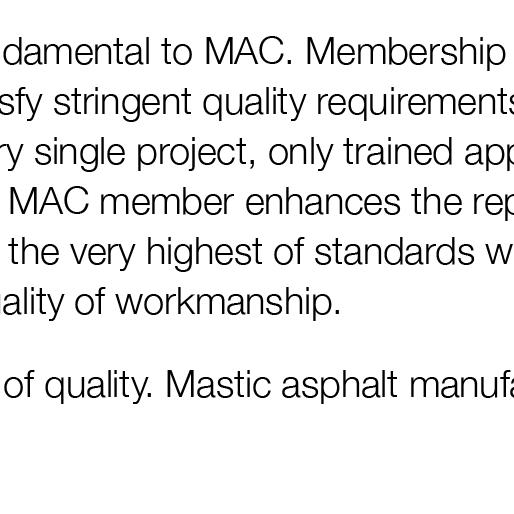










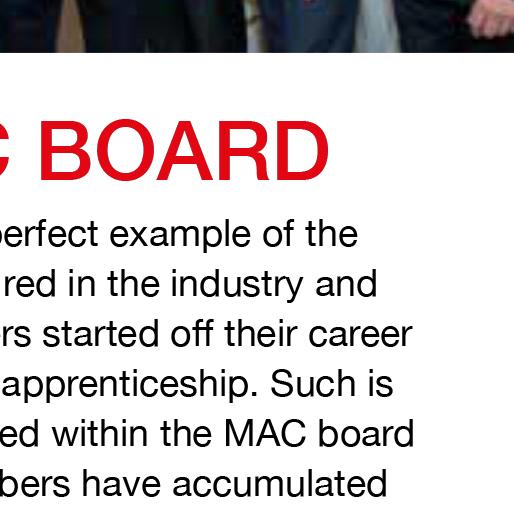





























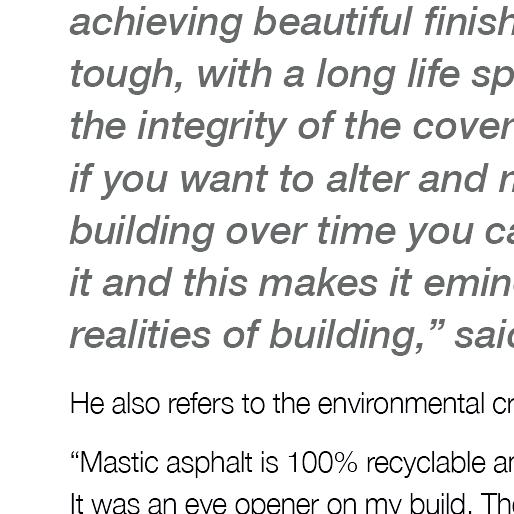


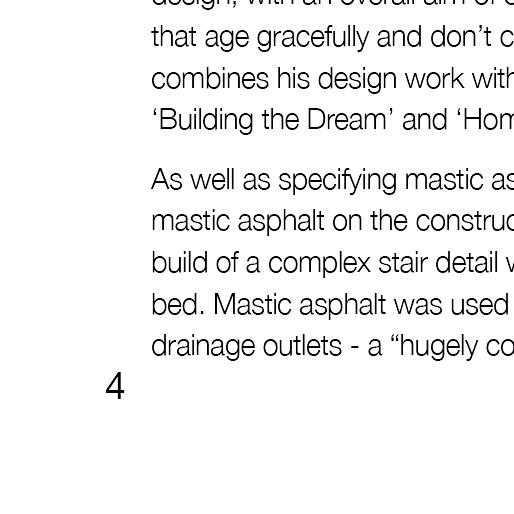


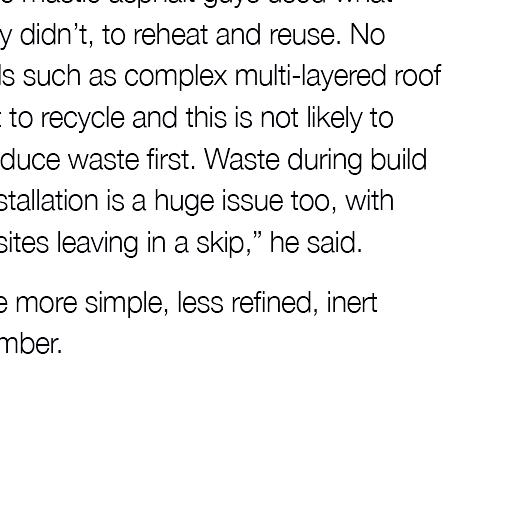
























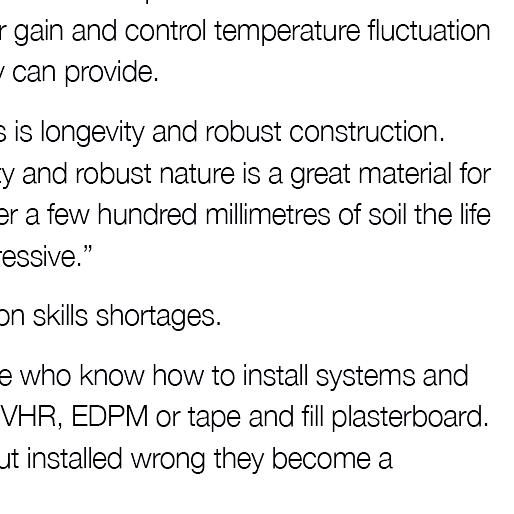



















































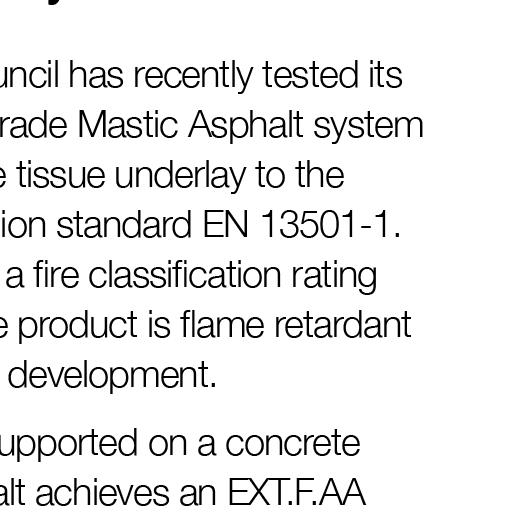



























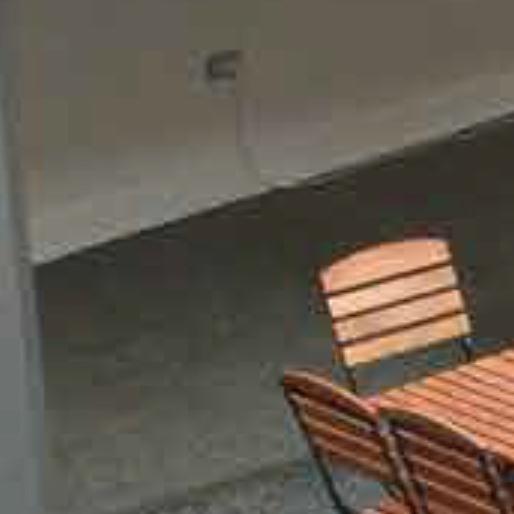






































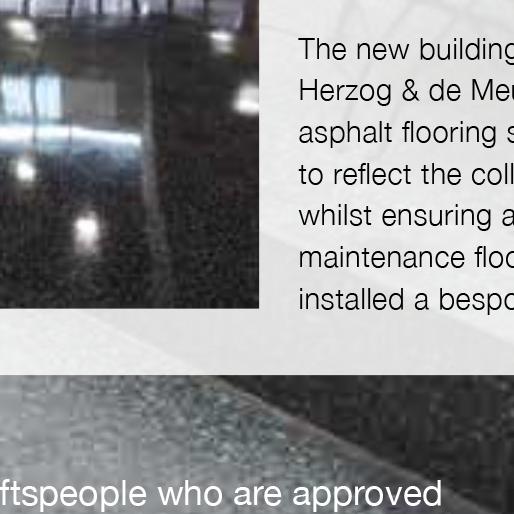




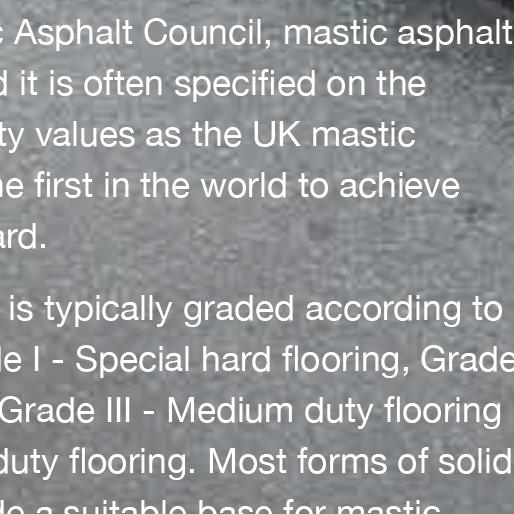














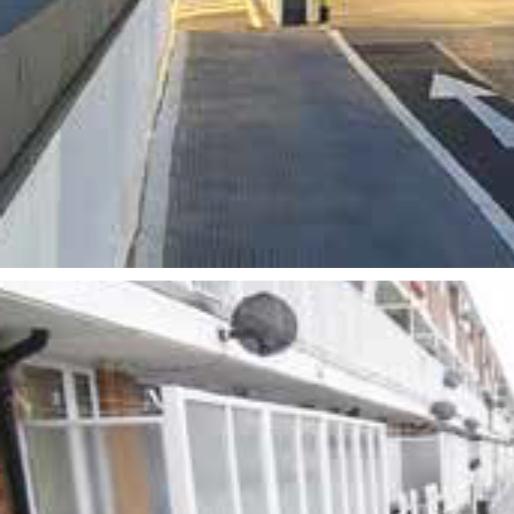
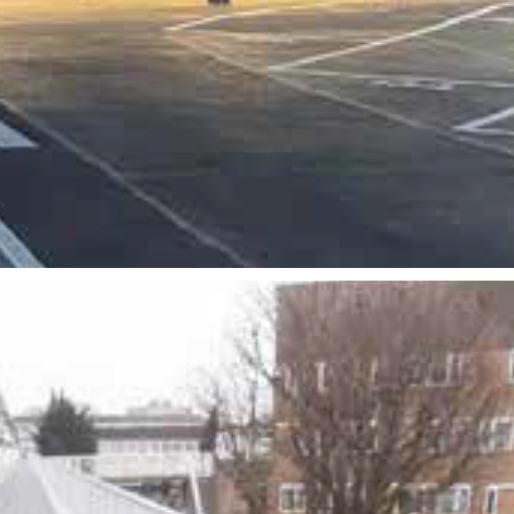




































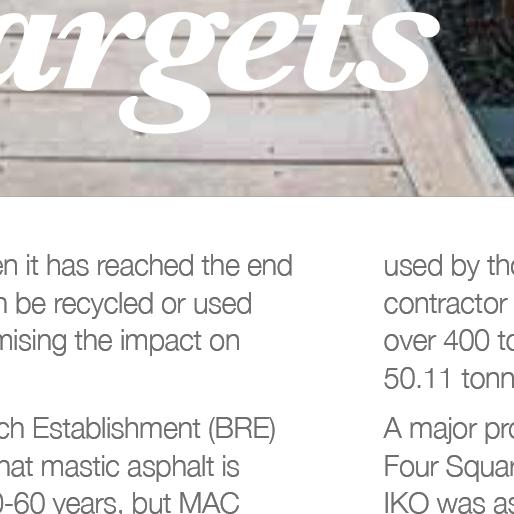



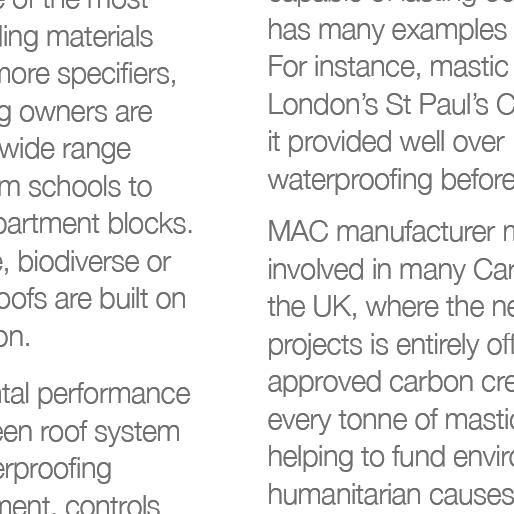





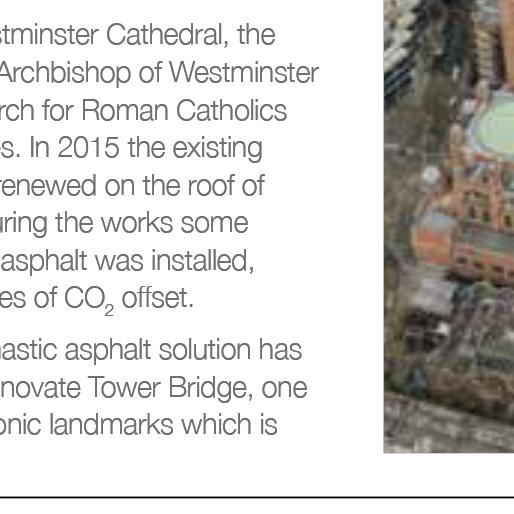



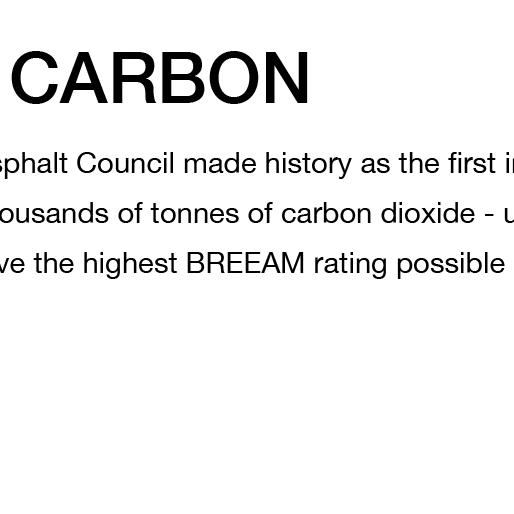



















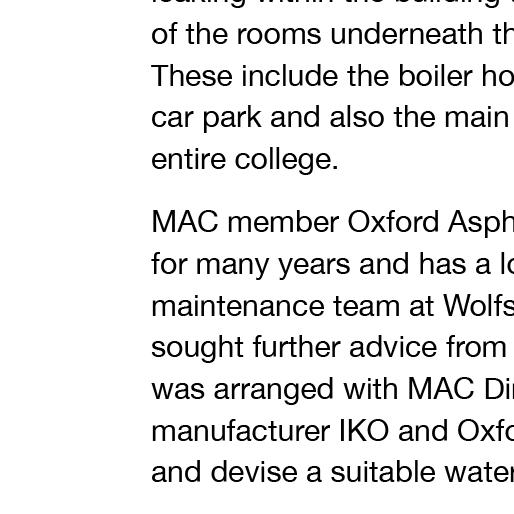
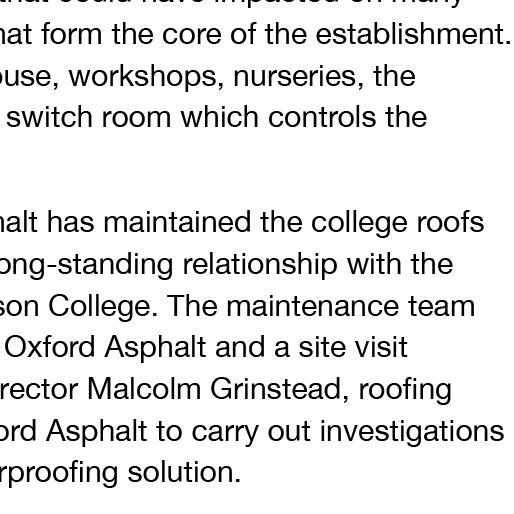
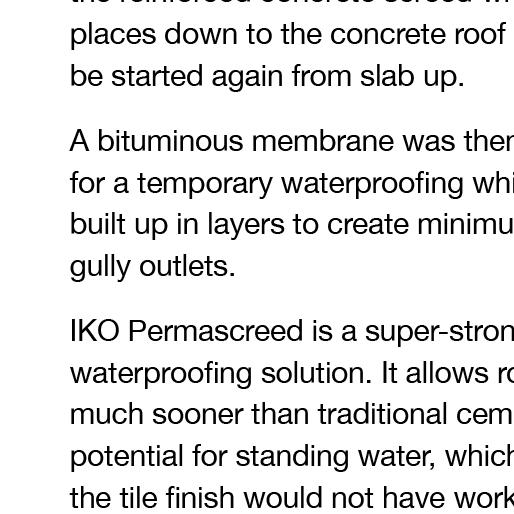




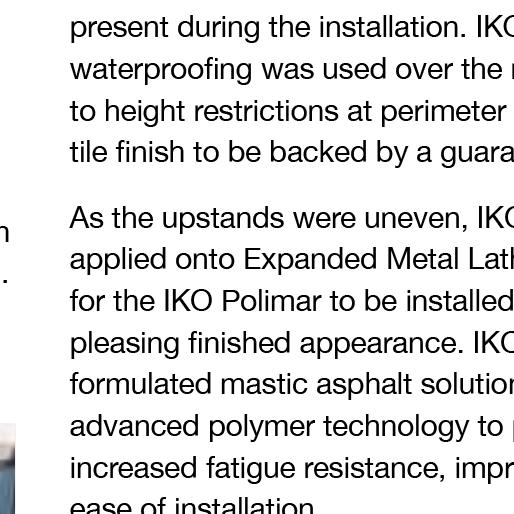


































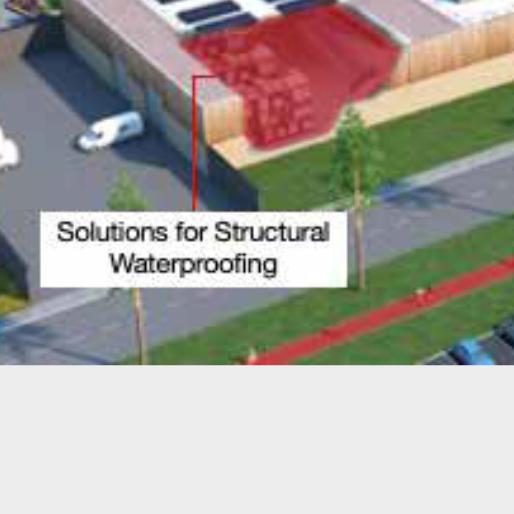














































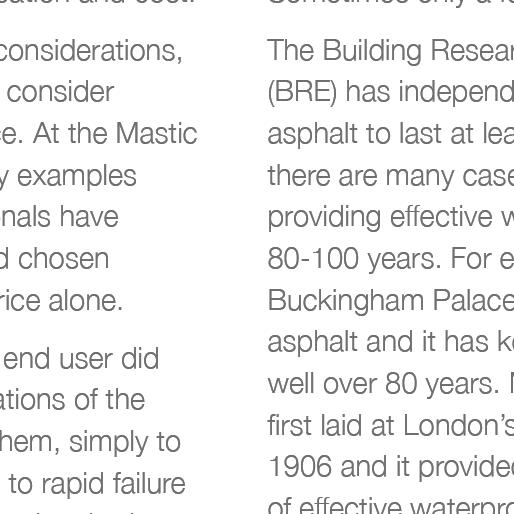




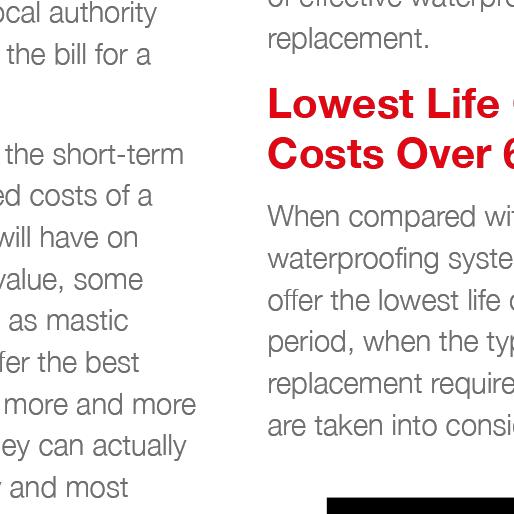











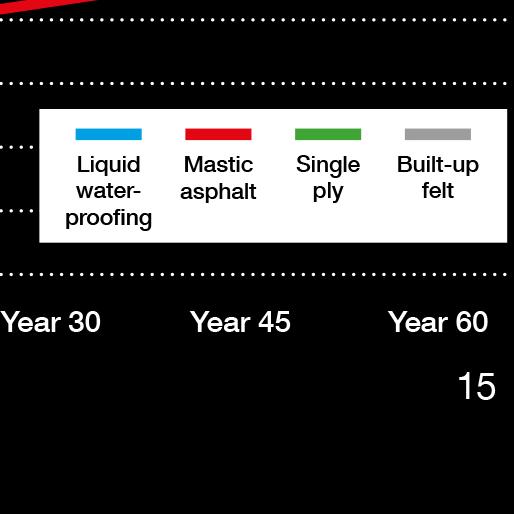











































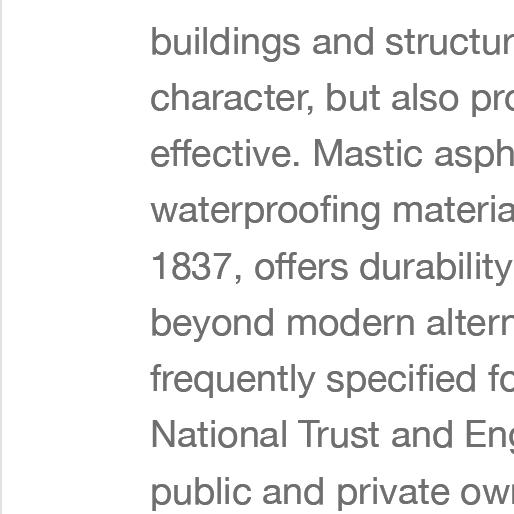
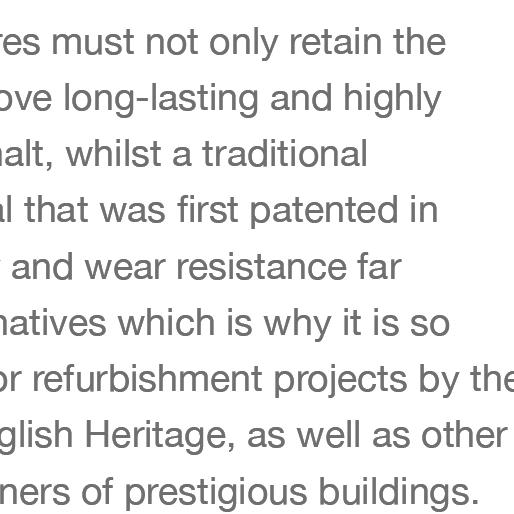










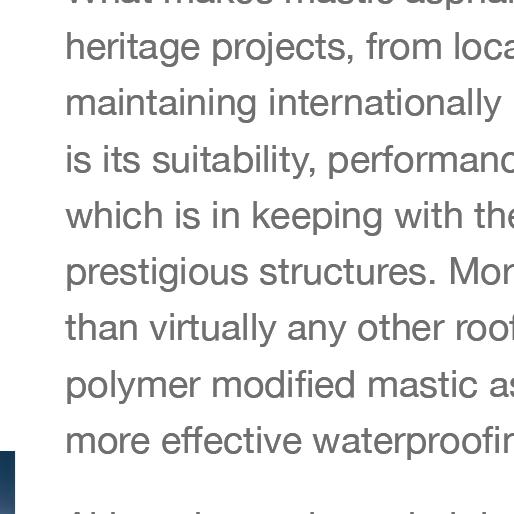
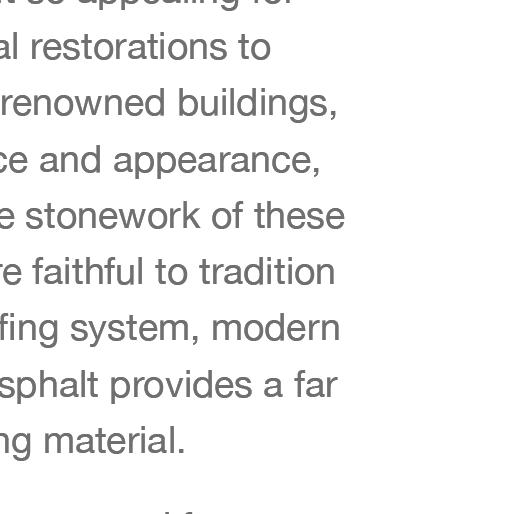
































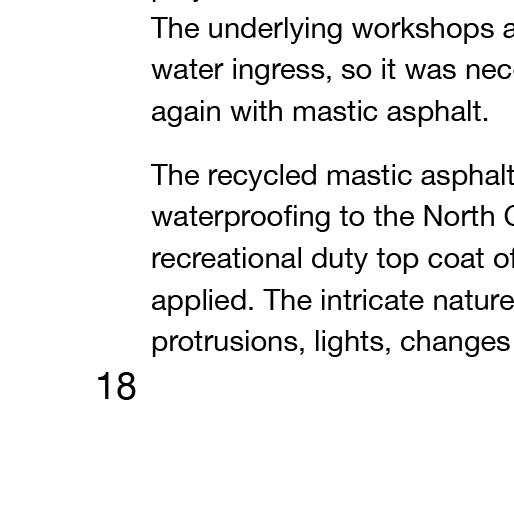

































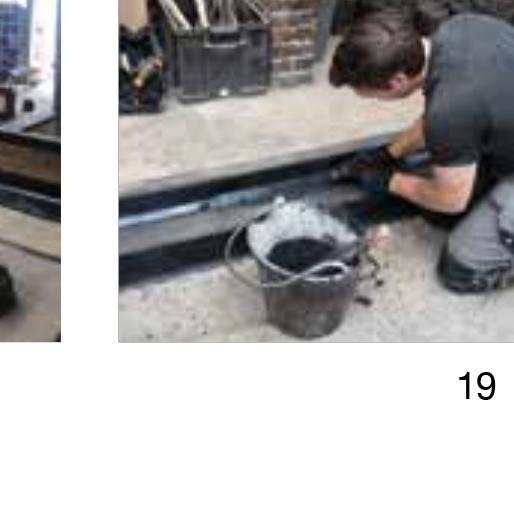






















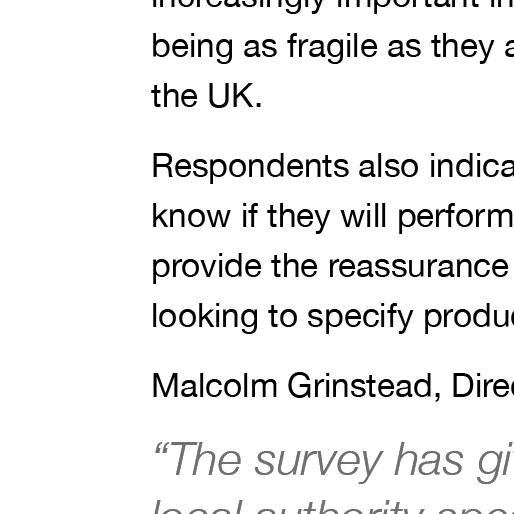





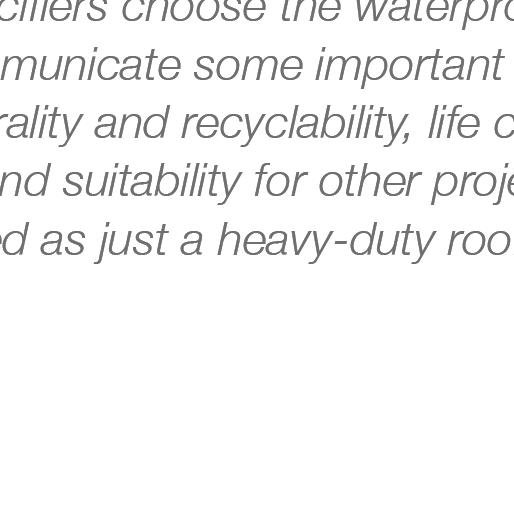


















































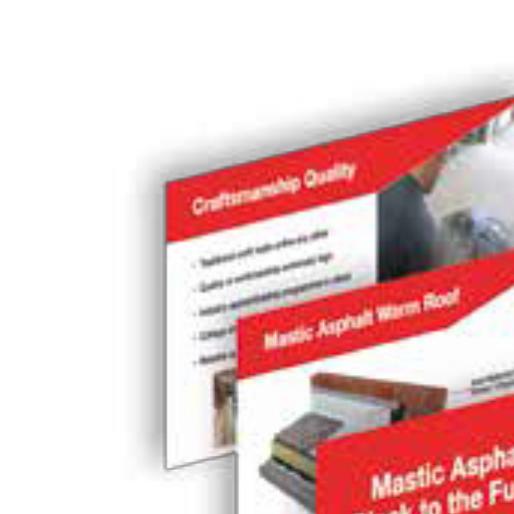







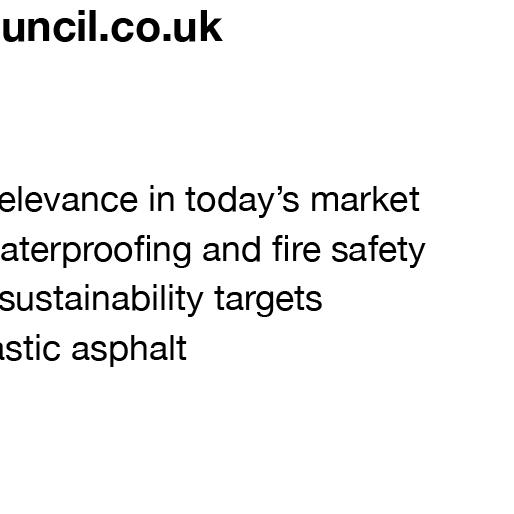


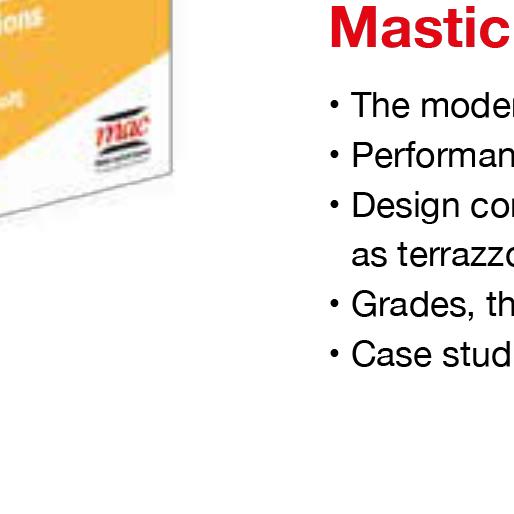


























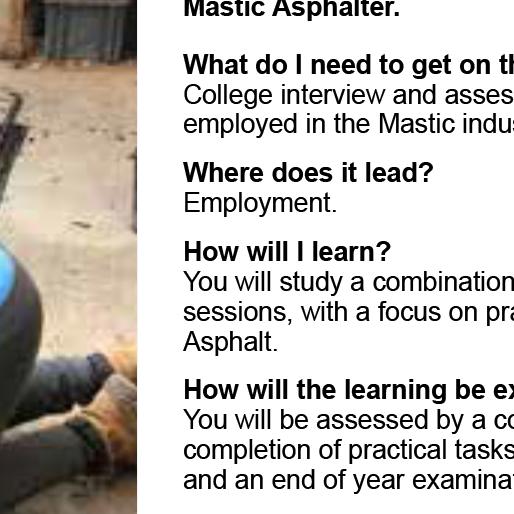







Mastic Asphalt Council Contractor Members
A & E Elkins Ltd
Brindley Asphalt Ltd
Kent Bell Asphalt Co
Kent
Black Rock Asphalt
Briggs Amasco Ltd
West Midlands
Falcon Asphalt
Bolton
Fraden Contracts Ltd
J B Asphalt Ltd & Flooring Ltd
Oxford Asphalt Co Ltd
Hull
Leeds
Romford
Greenroof UK Ltd
Knight Asphalte Co Ltd
Maidstone
Herts
Premier Mastic Asphalt Ltd
Prestige Asphalting Ltd Uk
Raynor Ltd
Rio Asphalt & Paving Co Ltd
Guaranteed Asphalt Ltd & Cladding Ltd
M & A Mastic Asphalt Ltd
Russell Trew Ltd
ISD Solutions
Southern Asphalt
Sussex Asphalte Ltd
Tucker & Tunstalls Ltd
Infallible Systems Ltd
masticasphaltcouncil.co.uk
John Fetherston







R E G I S T E R F O R F R E E AT W W W. P R O B U I L D E R L I V E . C O. U K T H E R E G I O N A L S H O W S F O R B U I L D I N G P R O F E S S I O N A L S COVERING ALL ASPECTS FROM HEATING AND PLUMBING TO BUILDING AND ELECTRICAL SERVICES ● FREE CPD SEMINARS ON LOW CARBON HEATING, FIRE SAFETY LEGISLATION AND EV CHARGING ● FREE ENTRY ● FREE PARKING FO RT H C O M I N G S H O W S : H&P HEATING AND PLUMBING T R A I N I N G Z O N E Professional LIVE! ELEX 2023 PROFESSIONAL ELECTRICIAN The Electricians’ Exhibition Sponsored by CBS ARENA COVENTRY CBS ARENA COVENTRY 14TH & 15TH SEPTEMBER 2023 WESTPOINT EXETER WESTPOINT EXETER 27TH & 28TH SEPTEMBER 2023 SANDOWN PARK SURREY SANDOWN PARK SURREY 2ND & 3RD NOVEMBER 2023

















































































































































































































































































































































































































































































































































































































































































































































































































































































